Let’s take a closer look at the different types of sushi!
The common seven types of sushi that every Japanese person knows of include Nigiri zushi (Nigiri sushi), Makizushi (Makisushi), Chirashizushi (Chirashi sushi), Inarizushi (Inari sushi), Sushi rolls, Oshizushi and Others. If you add in the local forms of sushi, there are as many types as there are regions. The most famous of these is nigiri-sushi, and it is what most out-of-towners are referring to with the word “sushi”.
1. Nigiri zushi (Nigiri sushi)
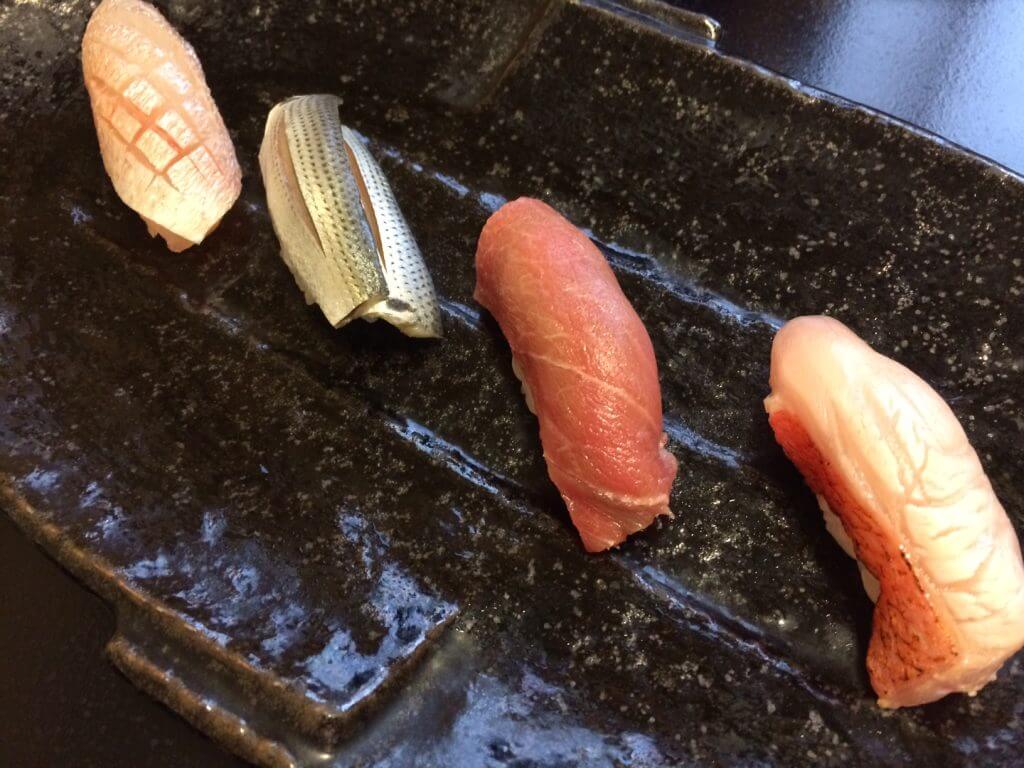
This type of sushi consists of placing a fish fillet or another topping on top of special vinegar rice, then pressing it by hand. You may be interested to know that salmon roe and sea urchin gun-kan pieces that are wrapped in seaweed aren’t rolled by hand like this, so some people don’t consider them to be nigiri-sushi. But the vinegar rice in these pieces is rolled by hand so wouldn’t that mean it’s one type of nigiri-sushi?! By the way, the name “nigiri” comes from the Japanese verb “nigiru” (to grip, press, or shape).
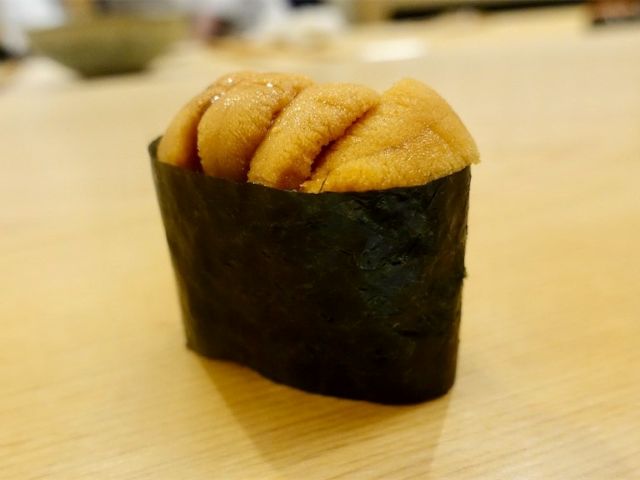
The appearance of Gunkan maki
Gunkan maki is a type of sushi that has a strip of nori seaweed wrapped around a rice ball, with a topping. Gunkan means “warship” in English. Gunkan maki was so named because it looks like a warship. Common toppings for gunkan maki are Ikura (salmon roe), Tobiko (flying fish roe), and Uni (sea urchin). It is said to have been invented in 1941 by ‘Kyubey’, a sushi restaurant in Ginza. The main category is Nigiri sushi, and the subcategory is Gunkan maki (Battleship sushi).
1-1 Caramelized salmon sushi
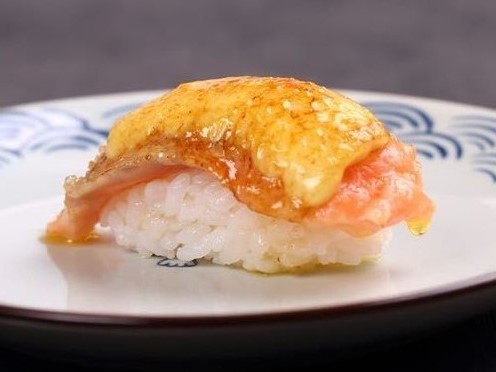
In the near future, it may be reimported from China, just like the California roll.
Japanese restaurants in China have made “Caramelized Salmon Sushi” a standard menu item. The salmon is placed on a piece of sushi rice, and the caramelized sugar is burnt on a burner to give it a crispy texture. Many restaurants add sweet mayonnaise for a more mild flavor.
1-2 Beef sushi
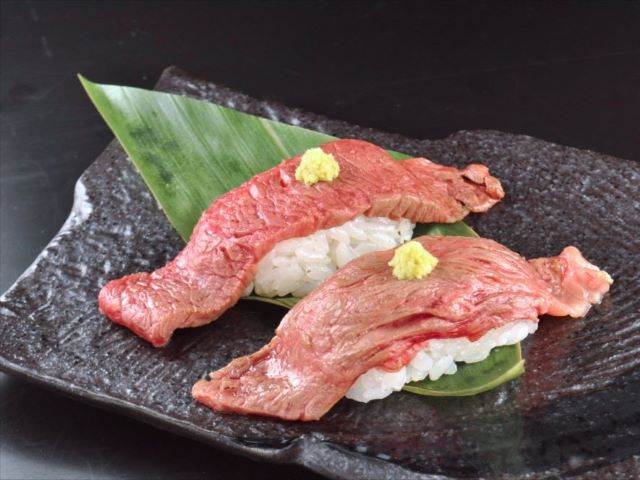
The appearance of Beef aburi sushi
Beef sushi is, as the name suggests, a dish in which raw beef is placed on vinegared rice and then seared slightly. The characteristic of this dish is that you can enjoy the natural umami of the meat by eating it raw. Another good point about beef is that, apart from the liver and internal organs, there are no bacteria or parasites that can cause food poisoning.
After all, vinegared rice goes perfectly with seared beef. It is a lighter way to enjoy the dish. As for condiments, anything goes, including green onions, garlic, wasabi, caviar, truffles, and sea urchins. This is why it is particularly popular with foreigners who come to Japan. However, it deviates from traditional Edomae sushi.
1-3 Inaka sushi (Vegetable sushi)
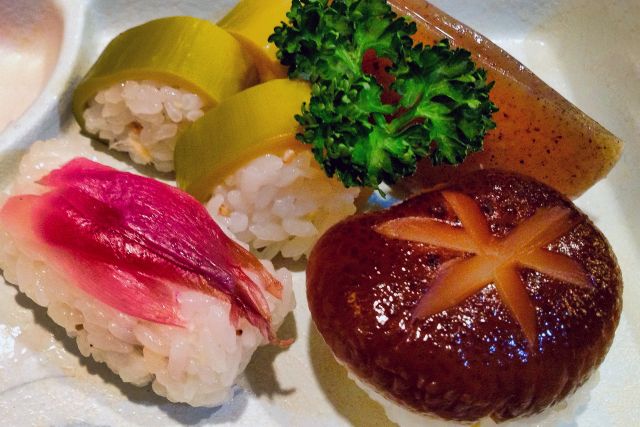
The appearance of Inaka sushi
This is a traditional seasonal dish from the mountainous areas of Kochi Prefecture, featuring sushi made with an abundance of mountain produce harvested locally.
It is said to have originated when kelp and seaweed were difficult to obtain, prompting people to create sushi using ingredients available in the mountains.
The ingredients vary by region but include the stems of the giant elephant ear plant (hasuimo), myoga ginger, konjac, and square bamboo (shidakudake), among others.
1-4 Shimazushi
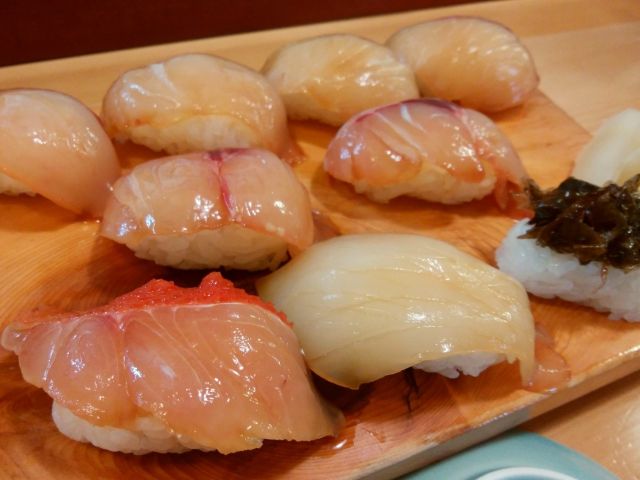
The appearance of Shimazushi
Shimazushi is a local dish from the Izu Islands, featuring sushi made with seasonal fish caught in nearby waters, marinated in a soy sauce (zuke), and served with slightly sweet vinegared rice and mustard instead of wasabi.
Originally, it was said to have been made as a way to preserve freshness when going out to sea, but today it has become a popular dish enjoyed for its delicious flavor.
While wasabi is typically used with sushi, in the Izu Islands and Ogasawara Islands, where wasabi was once unavailable, ground mustard was used as a substitute. Additionally, some use “Shimato soy sauce,” made by marinating unripe fruits of the island chili pepper known as “Aoto (Green chili)” in soy sauce to create a spicy flavor, or mix freshly chopped “Aoto” directly into the soy sauce.
The fish used for the sushi include swordfish, dolphinfish, chicken grunt (Isaki), greater amberjack (Kanpachi), Pacific barrelfish (Medai), deepwater longtail red snapper (Onagadai), blue fusilier, kinmedai, tuna, bonito, and flying fish, among others.It is also made in the Ogasawara Islands, which have a large population of immigrants from the southern Izu Islands and Hachijo Island, and in Ogasawara, using Spanish mackerel (Sawara) is common.
1-5 Fruit sushi (Dessert sushi)
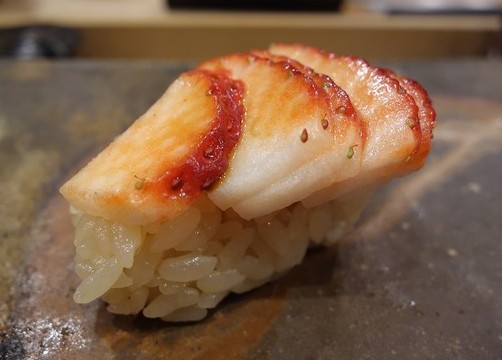
The appearance of fruit sushi
Fruit sushi is a creative dish in which fruits such as strawberries, mangoes, and kiwis are used as toppings for nigiri or maki sushi.
The acidity of the vinegared rice complements the sweet and tart flavors of the fruit, and its vibrant appearance makes it a popular dessert option.
It is said to have originated at The Sushi Room in Spain. In France, variations exist, such as sushi with fresh cream or chocolate-flavored vinegared rice.
Kinokawa City in Wakayama Prefecture is a fruit kingdom where, except for bananas and pineapples, virtually any fruit can be grown. There, fruit-based sushi was born with the cooperation of the local “Chikarazushi”.
1-6 Daitozushi
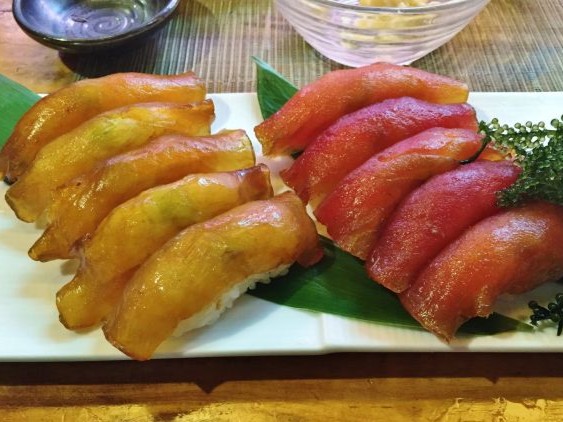
The appearance of Daitozushi
Daitozushi is nigiri sushi made by combining sweet vinegar rice with Japanese Spanish mackerel or tuna marinated in a special mirin soy sauce. It is said to have its roots in “Shimazushi” from Hachijojima, the homeland of pioneer immigrants, sharing characteristics like the use of slightly sweeter vinegar rice. The pleasantly sweet, sticky rice pairs well with the mirin soy-marinated fish, creating a delicious sushi with a rich, sweet flavor.
2. Makizushi (Maki sushi)
Makizushi is broadly categorized as Hoso-maki (thin rolls), Futo-maki (thick rolls), Saiku-maki (decorative rolls) and Temaki (hand rolls), which are actually a type of skinny rolls.
2-1 Hosomaki (Thin rolls)
The basic size of one piece of nori (dried seaweed) is L 210 x W 190 mm. This basic size is called “Zenkei (全型)”. Zenkei is cut to a variety of other sizes depending on how it is used. If you cut a sheet of zenkei nori in half, you will get the size you need for Hoso maki.
Rolls where one sheet of nori is grilled before use and then cut in half are called “Hosomaki”. The core of these rolls may be cucumber, tuna, dried gourd, pickled daikon radish, natto (fermented soybeans), or something else, and the rolls are named for these fillings. Around 80 grams of sushi rice is used for one Hosomaki roll.
One of the characteristics of Hoso-maki is that the way it is cut and served differs depending on the ingredients inside. For example, Kanpyo-maki is rolled so that the cross-section is round, cut into 4 pieces, and then presented on its side. Tekka-maki and Kappa-maki are rolled into square shapes, cut into 6 pieces, and then served to stand on the ends so that the red and green colors are visible. (It has been this way for many years, but the reason is not certain) Let me start by introducing the famous types of skinny rolls.
2-1-1 Kappa maki (Cucumber roll)
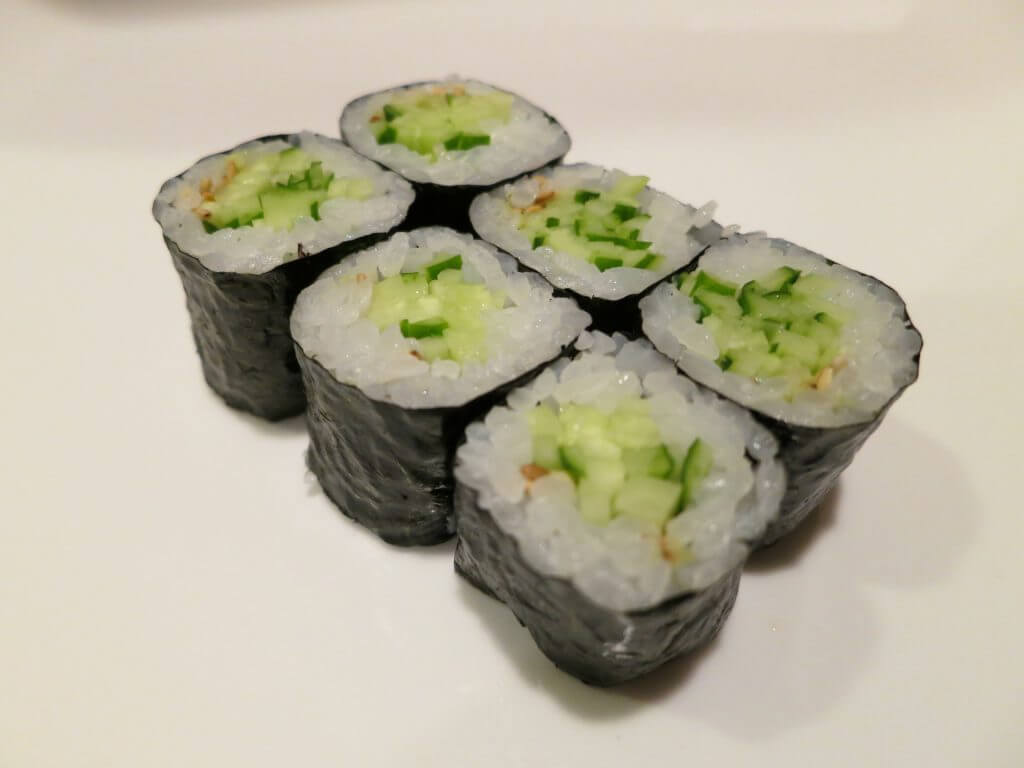
Cucumber is cut into long strips and a few of these strips, seasoned with white sesame seeds, are rolled into seaweed.
2-1-2 Tekka maki (Tuna roll)
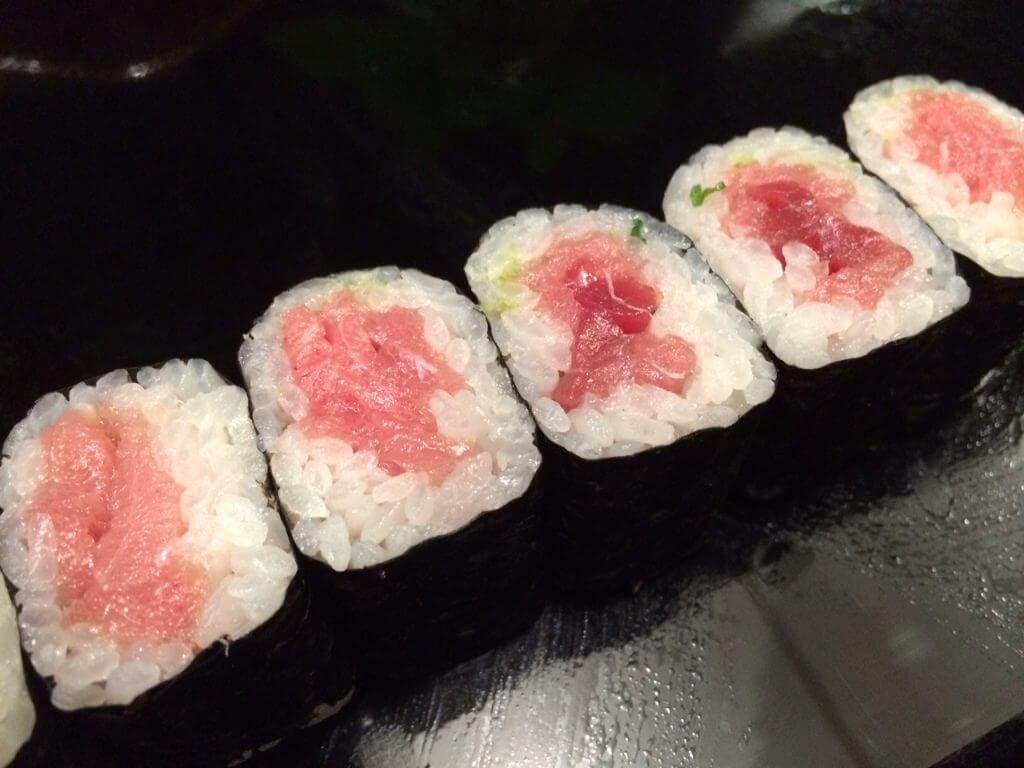
Most people already know the center of this roll is tuna.
2-1-3 Kampyo Maki (Dried gourd roll)
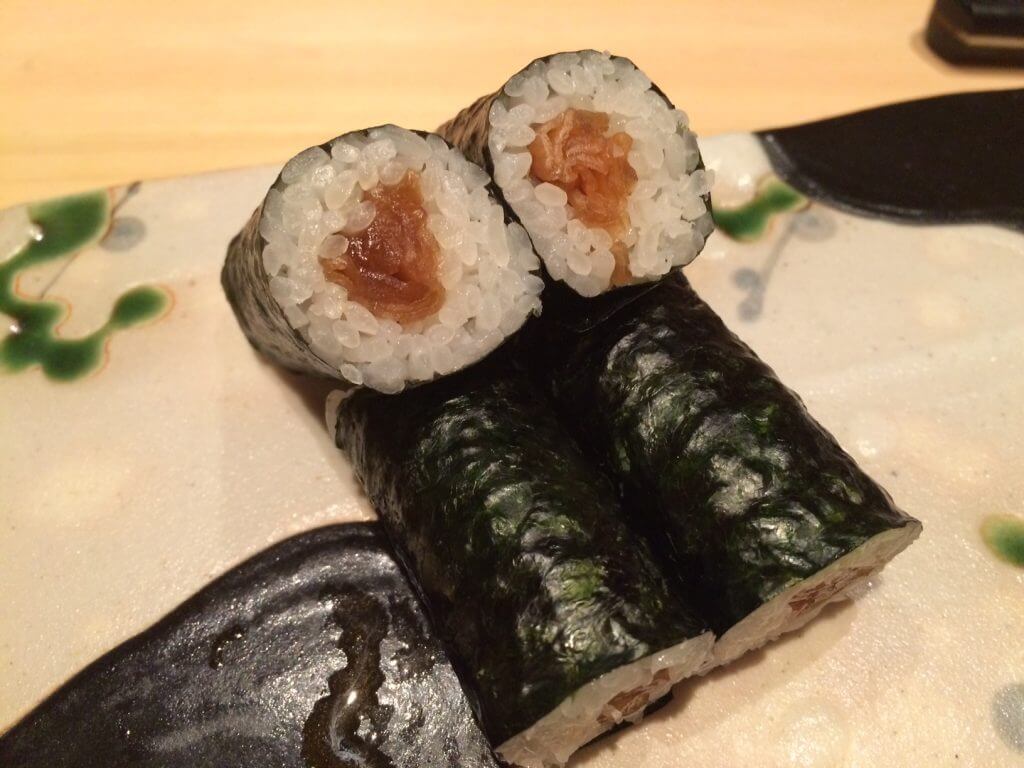
A seaweed roll with sweet, boiled Kanpyo* in the center.
*Kampyo is the white flesh of the bottle gourd, which is cut into long strips, as if peeling it, then cut so it looks like strings, then laid out to dry, perhaps in the sunshine or hot air.
2-1-4 Torotaku maki (tuna and pickled radish roll)
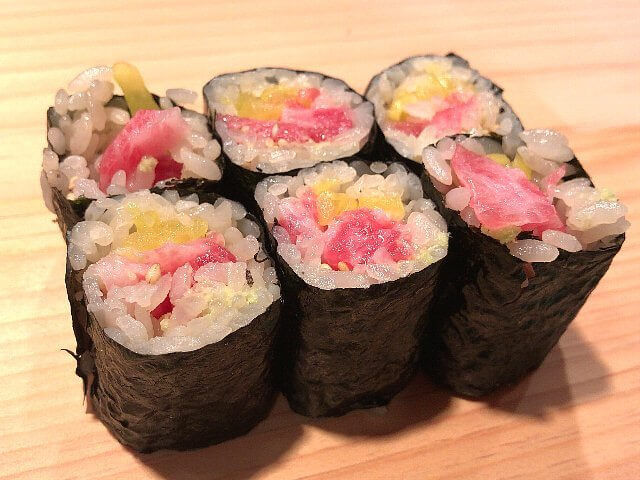
Chopped pickled radish is combined with sukimi* to form the center of this seaweed roll. The pickled radish has a refreshing flavor and matches perfectly with the thick fat of the tuna.
*Sukimi refers to a thin slice of the fish from which the meat between the muscle and the fat remaining on the back of the skin is cut away.
2-1-5 Anakyu maki (cucumber and conger eel roll)
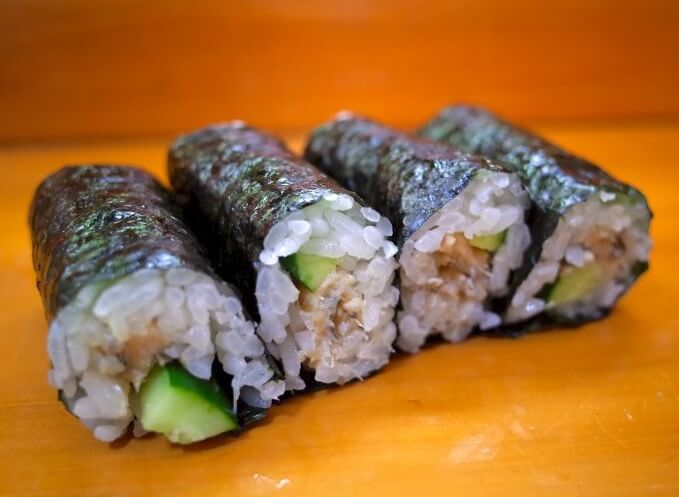
Finely sliced conger eel is combined with cucumber, then wrapped in seaweed.
The difference between unakyu roll (unakyu maki) and anakyu roll (anakyu maki)
The “una” in Unakyu is an abbreviation of “unagi” (Japanese eel) and “kyu” is an abbreviation of “Kyuri” (Japanese cucumber). In other words, a unakyu roll is a sushi roll made by wrapping Japanese eel, Japanese cucumber and sushi rice in nori (seaweed paper). Next, the “ana” in Anakyu is an abbreviation of “anago” (Japanese conger eel) and anakyu is a sushi roll in which Japanese conger eel, Japanese cucumber and sushi rice are rolled up in nori.
So what is the difference between eel and conger eel?
Biologically, they are both in the “unagi” or eel family. Basically, unagi lives in freshwater regions and conger eel live in the sea. However, in a Sushiology context, they are completely different types of toppings.
First of all, 99% of sushi restaurants that specifically serve Edo-style sushi, do not offer unagi sushi. Of course, unagi sushi exists in Japan, but it is more common in sushi shops in the Kansai region and as nigiri sushi at the conveyor belt sushi restaurants. In the Kanto region, unagi is eaten in the form of “unaju” (or unadon), which is unagi served over rice, at specialty restaurants called “Unagiya”. Incidentally, the basic eel sauce recipe used in unaju is made from sake, mirin, soy sauce and sugar. In Japan, it’s called “unagi-no-tare” (which means eel sauce) and is sold in grocery stores. As an aside, the secret eel sauce recipes used by unagi chefs bring out the natural sweetness of the sake and mirin, so using sugar is unnecessary.
On the other hand, anago sushi is a staple topping for Edo-style sushi and it is known as a topping that truly makes apparent the skill of the sushi chef. The sweet sushi sauce used for anago sushi is called Tsume (which is short for Nitsume; it’s not called ‘anago sauce’), made from the water that the anago was boiled in, sake, mirin, soy sauce and sugar. Besides anago, tsume is also used for hamaguri (clam), shako (squilla), awabi (abalone), etc. Eel sauce cannot be used as a substitute for tsume. Also, the flavor of the tsume is so important that it is often considered to be what a sushi restaurant is valued on, so the sauce recipe is always original at restaurants that display “Edo-style sushi” signs.
2-1-6 Himokyu maki (mantle and cucumber)
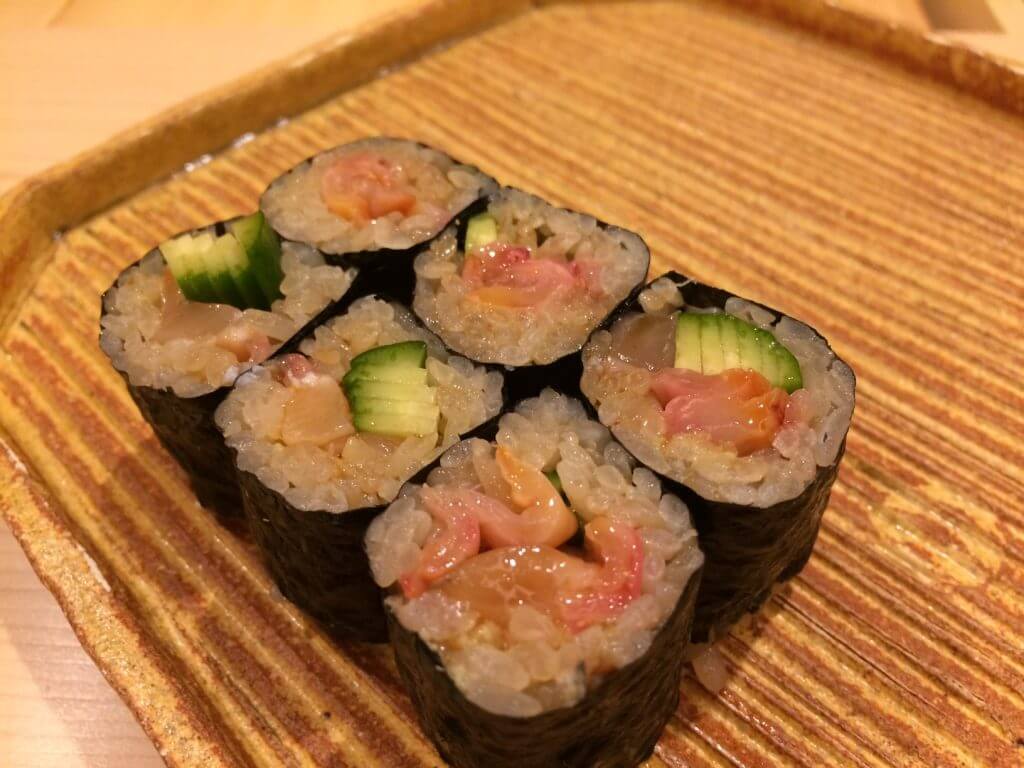
A seaweed roll with the mantle of the ark shell and cucumber in the center.
2-1-7 Negitoro maki (green onion and tuna)
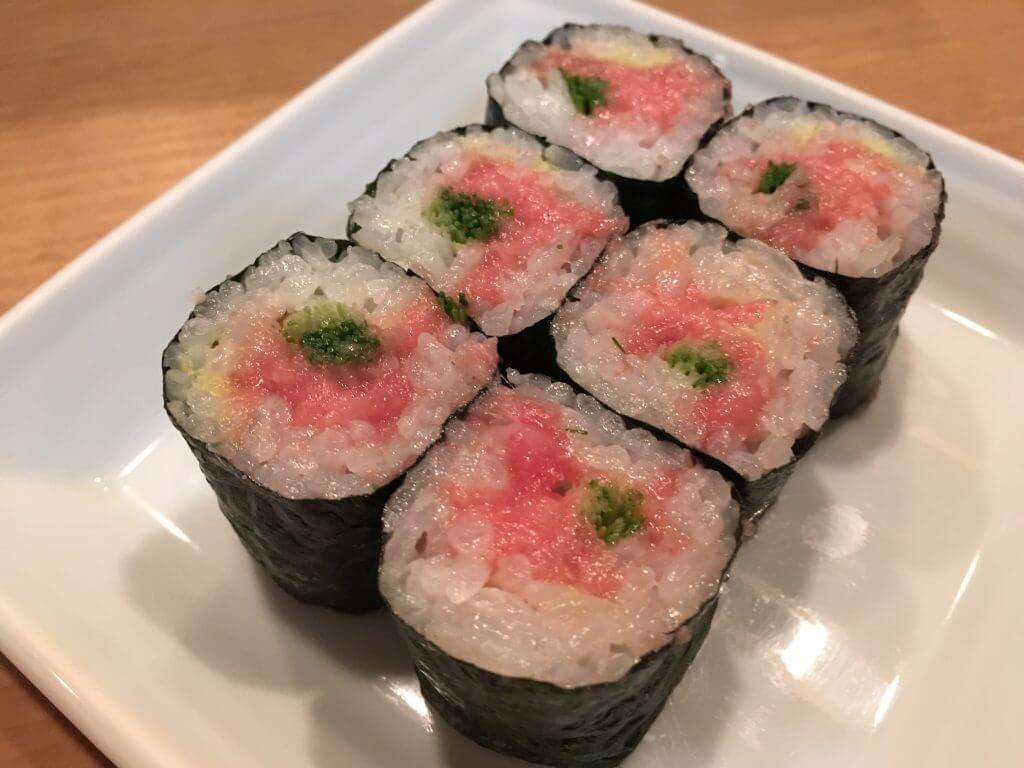
Chopped green onion is combined with tuna sukimi to form the center of this seaweed roll.
*There is a lot of flesh on the middle bone (spine) and the surrounding area for tuna and the like. This is called “nakaochi”. Scraping the meat from this area surrounding the spine is known as “negitoru”, which is where the word “negitoro” comes from. In other words, the name “negitoro” is not actually from the words onion (negi) and tuna belly (toro).
2-1-8 Shiko maki (Pickled radish roll)
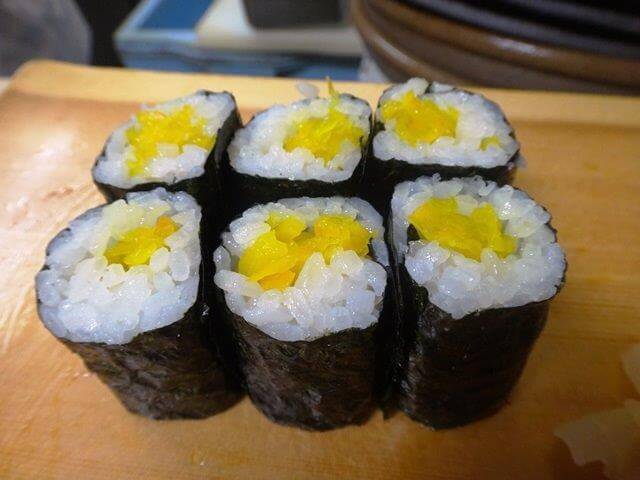
Chopped pickled radish and a shiso leaf are seasoned with white sesame seed and wrapped in seaweed.
2-1-9 Natto maki (Fermented Soybeans roll)
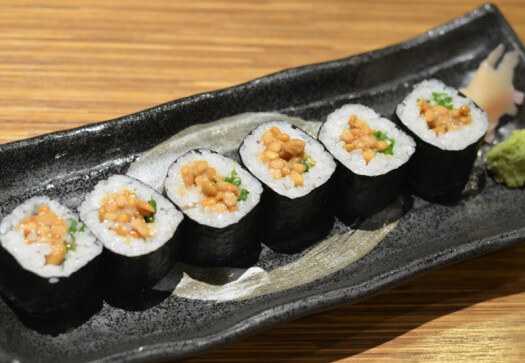
Natto is a fermented food made from steaming soybeans and the natto bacteria. It is considered to be one of Japan’s superfoods and its medically proven effects include preventing myocardial infarction and cerebral infarction, controlling increased blood sugar levels, preventing osteoporosis, anti-aging effects, improved memory, etc.
Natto maki, made by wrapping natto and sushi rice in nori, has seemed to spread throughout the world simultaneously with the recognition of natto. It is one of the most popular menu items at the conveyor belt sushi restaurants in Japan. However, let’s avoid ordering natto maki at Edo-style sushi restaurants in Japan. If you do, someone might think that you don’t understand what real sushi is. When Edo-style sushi was first invented, there were no vegetable toppings. Now, the only vegetable toppings in Edo-style sushi are cucumber, shiitake and spring onions. Natto is not considered to be a type of Edo-style topping and so it isn’t stocked at such restaurants.
2-1-10 Namida maki (Namida roll)
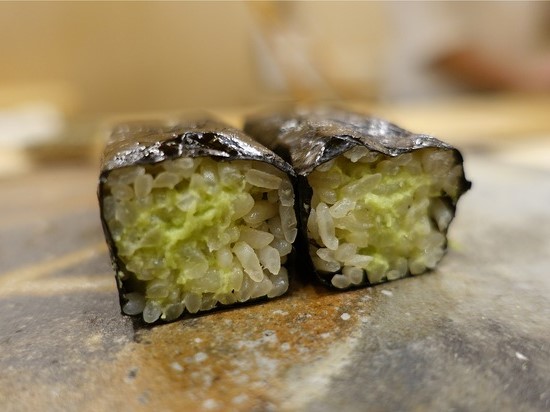
The appearance of Namida roll
Namida is the technical term for Wasabi in sushi restaurants. Eating Wasabi causes a twinge in the nose and tears, which is why Wasabi is called Namida (Tear) in sushi restaurants. It is a sushi roll with ground wasabi, chopped wasabi leaves, or shredded wasabi as a garnish.
It is a simple way to enjoy the taste and flavor of Wasabi, and to savor the umami of the nori seaweed and sushi rice.
2-1-11 Ume shiso maki (Pickled plum perilla roll)
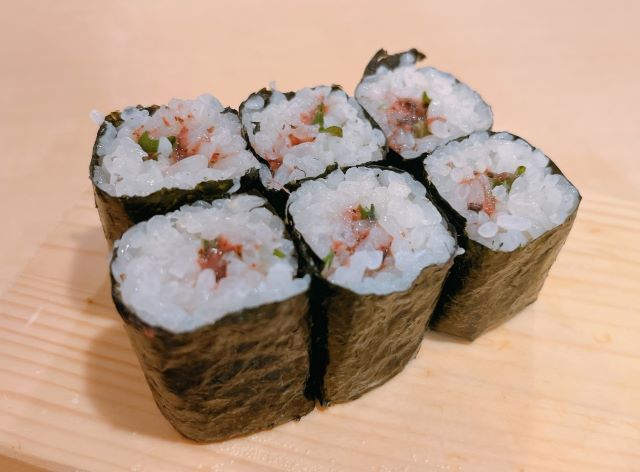
The appearance of Ume shiso maki
The true value of sushi as a palate-freshener is realized when the amount of ume plum paste, wasabi, shiso leaves, and roasted sesame seeds is in perfect balance with the vinegared rice. Ume plum paste is made by mashing dried plums, not the ones in a commercial tube.
2-1-12 Salmon maki (Salmon roll)
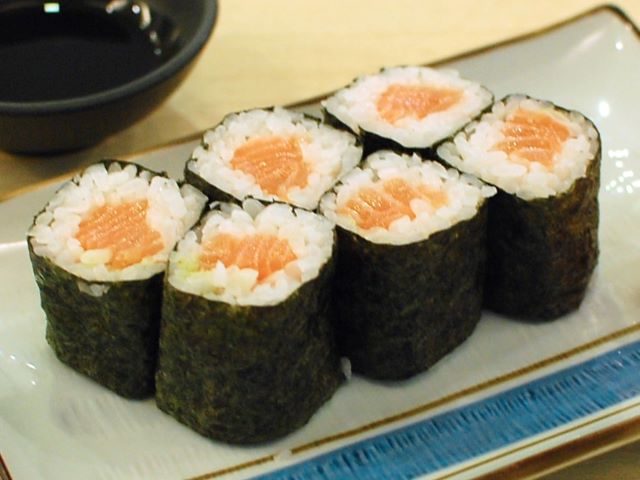
The appearance of salmon roll
No matter how popular salmon is as a sushi topping, it somehow loses its flavor when made into Norimaki. This is probably because the rich fat content of the salmon does not go well with the nori seaweed. So the sushi chef takes an extra step and makes the salmon into zuke. This makes it into a much more luxurious Norimaki.
2-1-13 Tamago maki (Dashi rolled egg omelette roll)
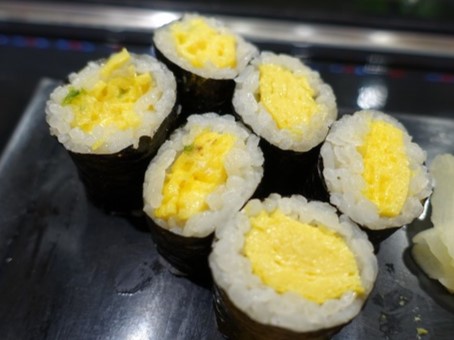
The appearance of Tamagomaki
This is a sushi roll made with a core of dashi rolled egg omelette. You can get this at any sushi restaurant that serves dashi rolled egg omelette. The combination of vinegared rice and dashi rolled egg omelette is perfect and appeals to mature palates. Although it was not created by a sushi restaurant, it is sold as a frozen food and is a big hit.
2-1-14 Sujiko maki (Sujiko roll)
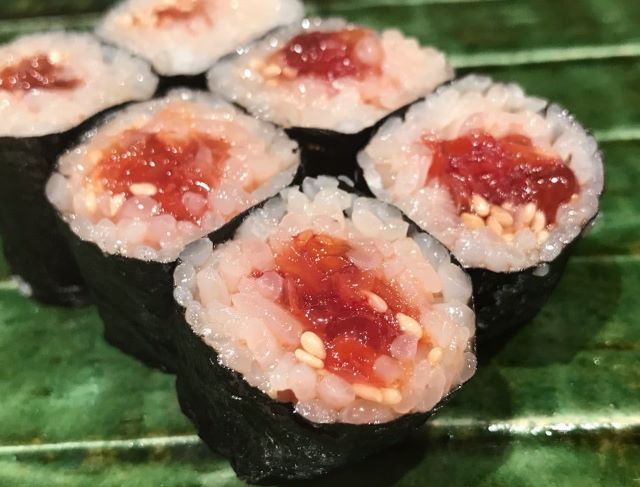
The appearance of Sujiko maki
Sujiko is salmon or trout roe that has been salted or marinated in soy sauce while still wrapped in the membrane that covers the ovaries. Ikura, on the other hand, refers to the eggs that have been removed from the sujiko and separated. Sujiko maki is a nori roll with the sujiko at its core. When you put sujiko maki in your mouth, the thick, rich juice spreads out and the distinct saltiness hits your tongue.
2-1-15 Kohada oboro maki (Gizzard shad oboro roll)
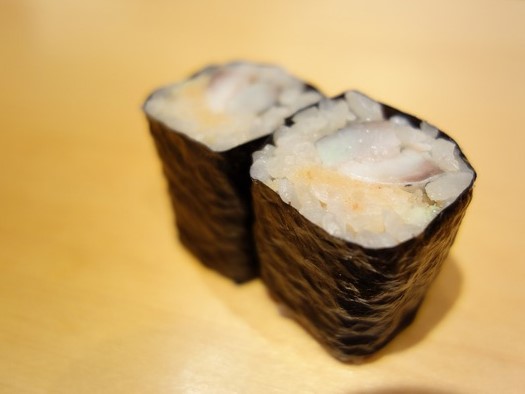
The appearance of Kohada oboro maki
To be honest, the vinegar in traditional Kohada nigiri sushi is often too strong. This is because Kohada quickly loses its freshness, so it had to be preserved by making it into sujime (soaked in vinegar). If you make Kohada into hosomaki, the vinegar rice is reduced, so you will be able to taste the vinegar more strongly. As a solution, the sushi chefs add sweet Oboro to temper the sourness. Oboro is rich in the umami and aroma of shrimp, and it elevates the Kohada maki to a more luxurious and mellow Nori maki. It is different from the Kohada maki, which is a side dish that does not use vinegared rice.
2-1-16 Oboro maki (Oboro roll)
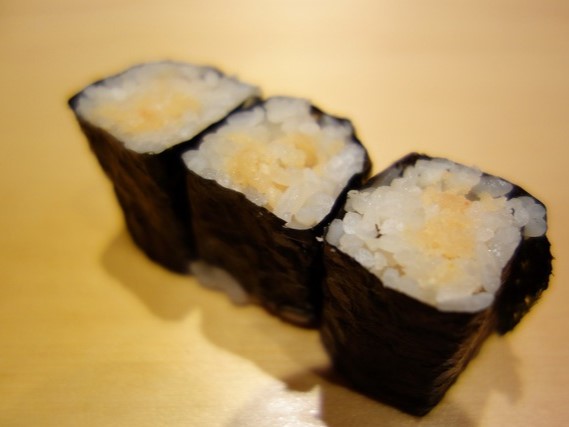
The appearance of Oboro maki
Oboro is more of a supporting role, but there are fewer and fewer sushi chefs who make Oboro. It’s not that they can’t make Oboro, but rather that they don’t want to make it because it’s too much trouble. You can’t gauge a chef’s skill by looking at Oboro, but you can sense their motivation. Oboro is always served at sushi restaurants with a long history, so it’s the kind of thing that only serious sushi lovers would order.
2-1-17 Uni maki (Sea urchin roll)
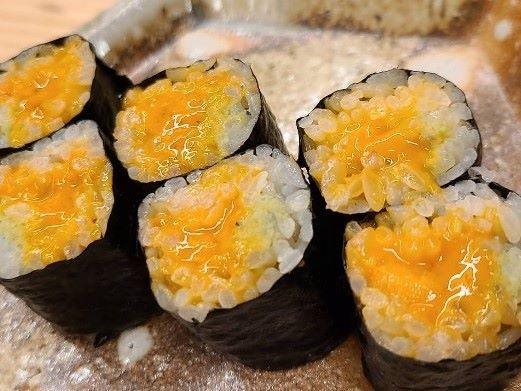
The appearance of Uni maki.
Uni (Sea urchin) is used as the core and rolled into a Hoso-maki. Te-maki and Gunkanmaki are also good, but it seems that Uni lovers can’t help but try this too. This is a menu that is less out of place than Te-maki, which uses sea urchins that look like they might spill out.
2-1-18 Yama gobo maki (Burdock root pickles roll)
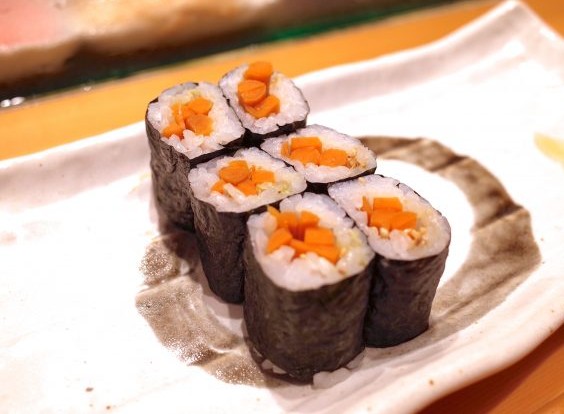
The appearance of Burdock root pickles roll
When burdock root, which is about 20 to 30 cm long, is pickled in miso, it turns a bright orange color. This is then cut into several pieces and wrapped in nori and vinegared rice.
2-1-19 Tarako maki (Cod roe roll)
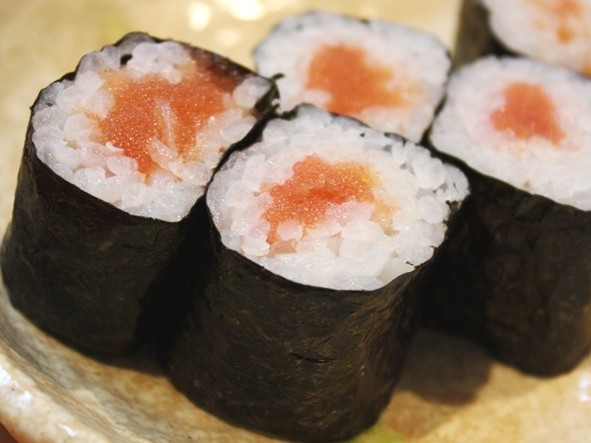
The appearance of Tarako maki
There is no tarako at Edo-mae sushi restaurants. However, the tarako rice balls are incredibly delicious, so you can imagine how delicious the sushi must be. Some regular customers even ask for tarako rolls, even though they know it’s not available.
2-20 Unakyu maki (Cucumber and eel roll)
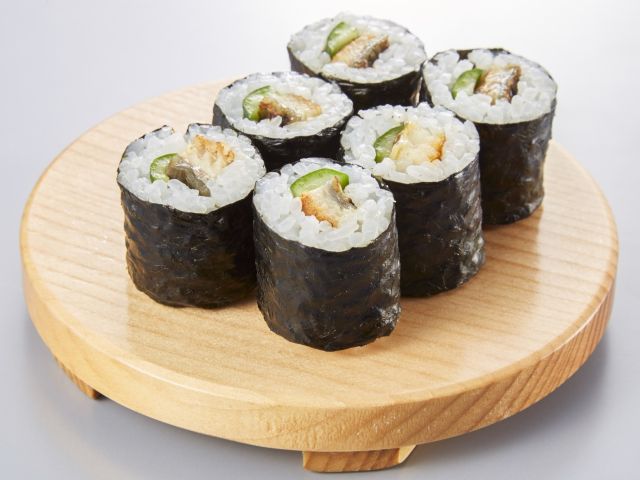
The appearance of unakyu maki
Unakyu maki is a sushi roll made with grilled eel and cucumber wrapped in vinegared rice. It combines the rich flavor of eel, the sweetness and savory aroma of the sauce, and the refreshing crunch of cucumber.
2-2 Futomaki (Thick rolls)
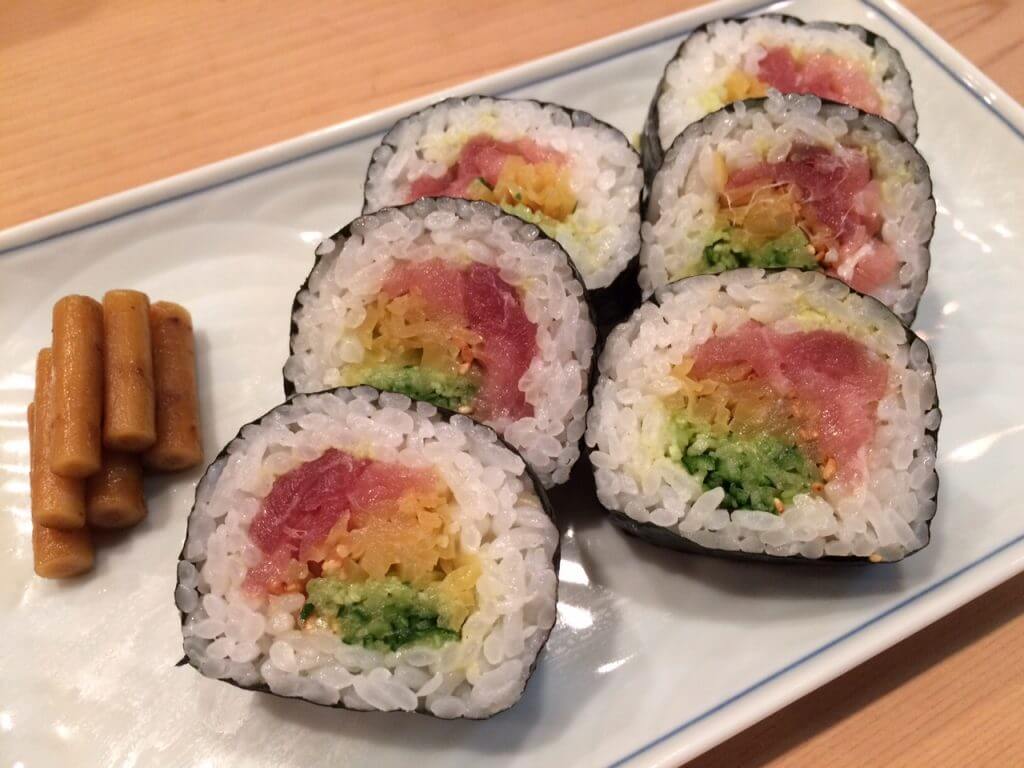
These sushi rolls are thicker. In the Kansai region, Futo-maki are made with 1 and a half sheets of nori seaweed while in the Kanto region only one sheet is used. Also in Kanto, the nori is toasted, but it’s not in Kansai. The reason for not toasting is that soft, raw nori that has only been dried is easy to roll vinegar rice in and doesn’t tear easily. The typical Futo-maki roll is the Goshu-goshoku (5 types, 5 colors) including shiitake mushrooms, kanpyo, egg omelet, minced fish, and spinach.
There are a lot of temples and shrines in the Kansai area, and it is closely connected to Buddist rituals: the futomaki of old were filled with Zen Buddhist vegan ingredients such as freeze-dried tofu (Koya tofu), dried gourd strips (kanpyo), shiitake mushrooms, and the parsley-like herb mitsuba.
In Kansai, there is more vinegar rice used so it is rolled very thickly, but in Kanto the ingredients and vinegar rice are balanced and the roll is thinner.
For Futo-maki one sheet of nori is used to roll 250 to 300 grams of sushi rice and ingredients. There is also a version called Chu-maki in which Futo-maki is made a bit smaller so it is easier to eat in the restaurant, and about three cuts are served with the main dish. However, the line between Chu-maki and Futo-maki is not clear-cut.
2-2-1 Hikarimono Nori maki (Hikarimono roll)
Some regular customers who love Aji, Saba, Iwashi, Kohada, etc., called Hikarimono, ask for them as Nori maki. These do not use vinegared rice, so they are only to be ordered as a snack with sake. Some sushi restaurants have these as a regular menu item, but you can order them at any sushi restaurant and they will make them for you.
2-2-1-1 Iwashi Nori maki (Sardine roll)
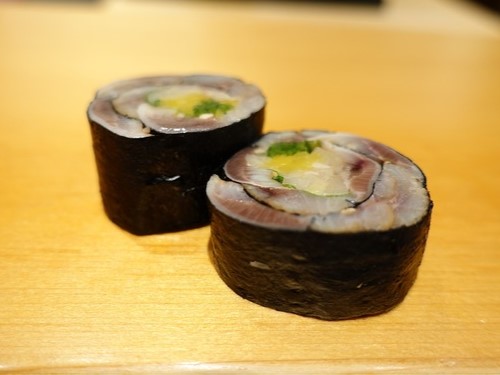
The appearance of Iwashi maki
Maiwashi sujime is made into a Nori maki with a core of ooba (perilla leaf), myoga (Japanese ginger), gari, and menegi.
2-2-1-2 Aji Nori maki (Horse mackerel roll)
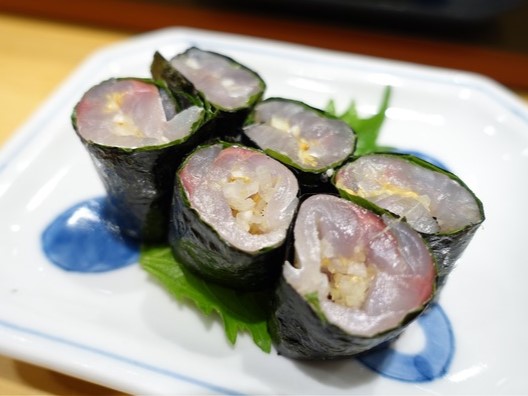
The appearance of Aji nori maki
Aji sujime is made into a Nori maki with a core of ooba (perilla leaf), myoga (Japanese ginger), and gari (ginger). Of course, it can also be made with Hoso maki instead of Futo maki.
2-2-1-3 Saba Nori maki (Mackerel roll)
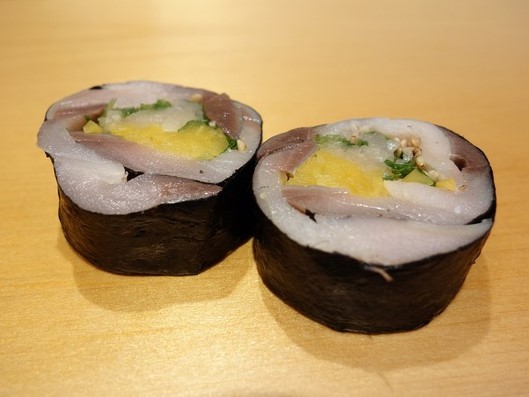
The appearance of Saba Nori maki
Saba sujime is made into a Nori maki with a core of ooba (perilla leaf), shirogoma (white sesame), and gari (ginger).
2-2-1-4 Kohada Nori maki (Gizzard shad roll)
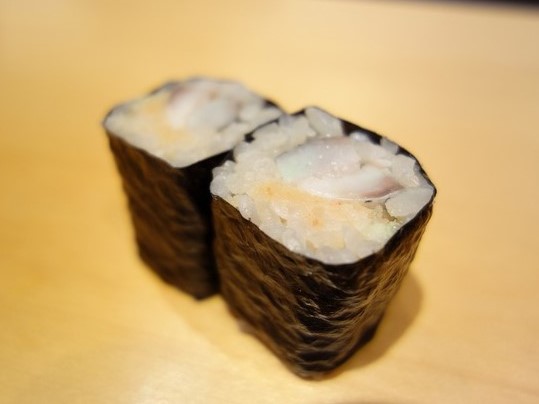
The appearance of Kohada Nori maki
Kohada sujime is made into a Nori maki with a core of oboro.
2-2-2 Nonojimaki
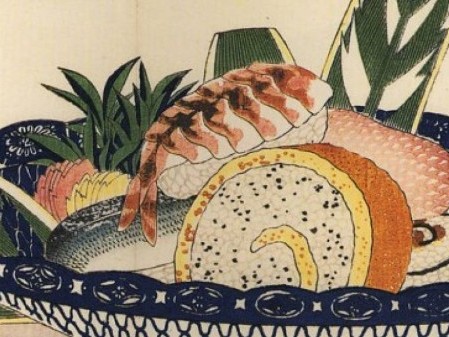
This futomaki (thick roll) is unique in that it is made by wrapping vinegared rice in tamagoyaki (Japanese omelet). It seems to have been around since the Edo period. It was named after the hiragana letter “の” because it resembles the shape of the letter. It was originally a luxurious sushi dish created for the leisure district.
2-2-3 Ehomaki
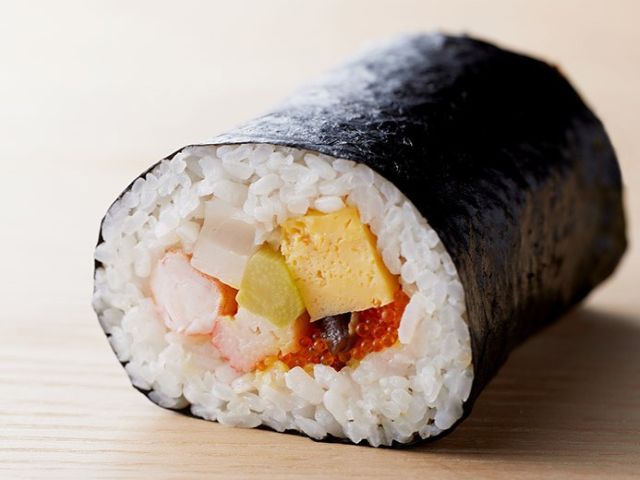
Thea appearance of Ehomaki
In this rather unique custom, you eat a thick, rolled sushi called ehomaki whole, while facing the direction that is said to be lucky for the year.
Seven Gods of Fortune symbolize wealth and happiness in Japan. The ingredients are traditionally seven types, inspired by the Seven Lucky Gods, but there are no strict rules, so feel free to use your favorite ingredients. However, anago and eel kabayaki, egg, and boiled shiitake mushrooms are popular choices. This trend has spread nationwide thanks to seaweed sales promotions and convenience store chain marketing strategies.
2-2-4 Isomaki sushi
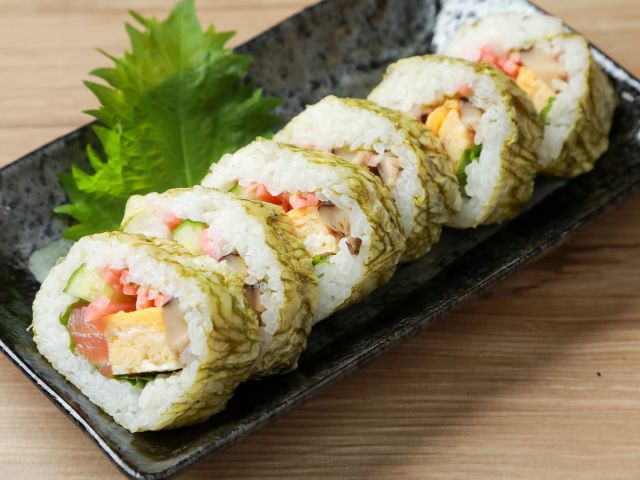
The appearance of Isomaki
Isomaki sushi is made by wrapping vinegar rice around slices of marinated mackerel with tororo kombu (shavings of kelp). Tororo kombu is used instead of nori seaweed. It is called Isomaki sushi because of its iso aroma (seaweed aroma).
2-2-5 Datemaki
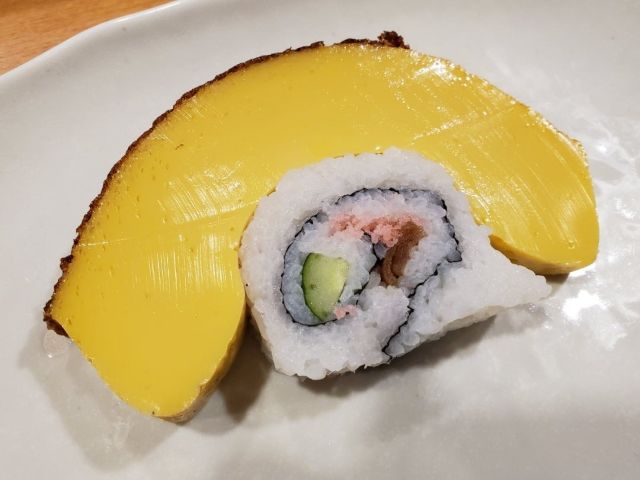
The appearance of Datemaki
Datemaki is a type of sushi characterized by thick omelet strips placed on top of vinegared rice and other ingredients in a half-moon shape. It is said that fishermen, who worked hard at sea, enjoyed eating sweet foods to relieve their fatigue, and this Datemaki is also known as “fisherman’s pudding.” It is a specialty of Choshi, Chiba Prefecture.
2-2-6 Nankanagemaki
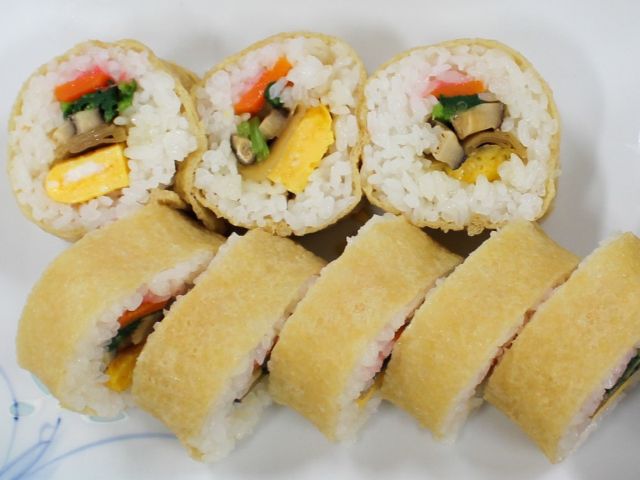
The appearance of Nankanagemaki zushi
Nankanagemaki zushi is made by nankanage (fried tofu), drained the oil, simmering it in soy sauce and sugar to create a sweet and savory flavor, and using it in place of nori seaweed.Squeeze out the cooking broth, open the fried tofu, place it on a sushi mat, spread the sushi rice on top, and roll it up with shiitake mushrooms, carrots, omelet, and other typical makizushi toppings.
This is a local dish from Nankancho in Kumamoto Prefecture.
2-2-7 Tosa maki
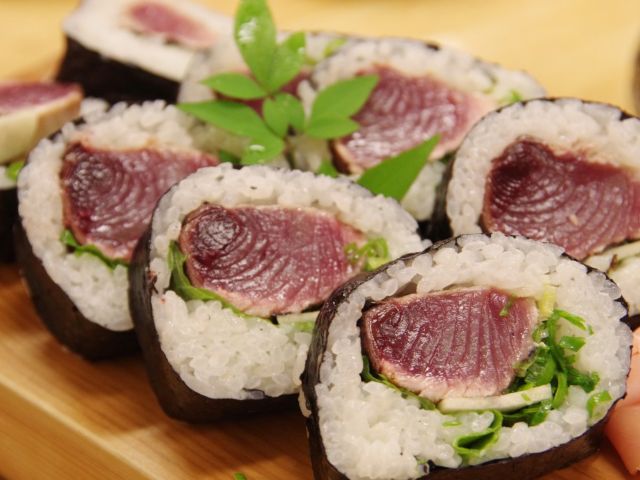
The appearance of Tosa maki
Tosa maki is a thick sushi roll filled with seared bonito, raw garlic, shiso leaves, and other seasonings. It is a local dish of Kochi that can be found at sushi restaurants, izakaya, and supermarkets. It is said to have originated at Kikusushi.
2-2-8 Hiroshima-na maki
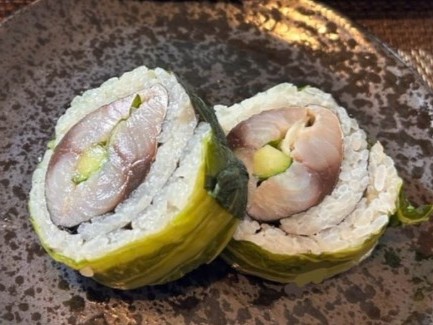
The appearance of Hiroshimana maki
Hiroshima-na is a pickled vegetable made from a variety of Nozawa-na that has been bred. Sushi rice is placed on top, and chopped Hiroshima-na is used as a filling and rolled up. The filling also includes mackerel and soy sauce-flavored bonito flakes.
2-2-9 Lettuce maki
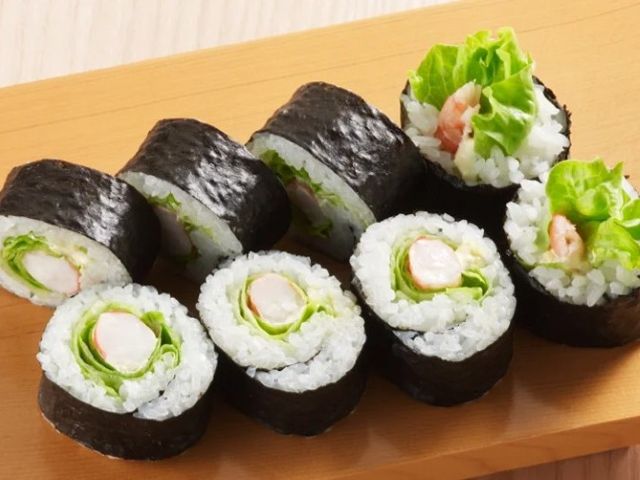
The appearance of Lettuce maki
Lettuce maki are sushi rolls filled with boiled shrimp, lettuce, and mayonnaise. These sushi rolls, which combine Japanese and Western flavors with the use of original mayonnaise, were undoubtedly innovative when they first appeared. Today, salad rolls, which are sushi rolls with a salad-like flavor, are popular throughout Japan, but the origin of these rolls is the “lettuce roll.” The origin of this dish is said to be the long-established sushi restaurant “Ippei” in Miyazaki City.
2-2-10 Wakame maki
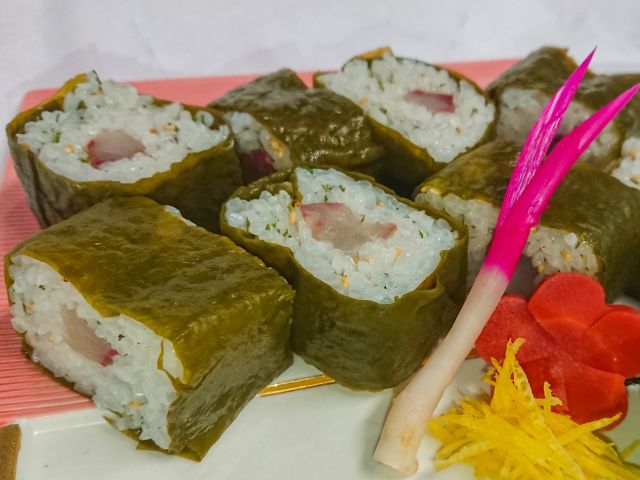
The appearance of Wakame maki
This sushi is rolled using Hariwakame instead of nori seaweed. Hariwakame is made by spreading the tender parts of freshly harvested wakame seaweed into flat sheets and drying them. The fillings include carrots, burdock root, dried gourd strips, freeze-dried tofu, and pickled daikon radish.
2-3 Chumaki (Middle rolls)
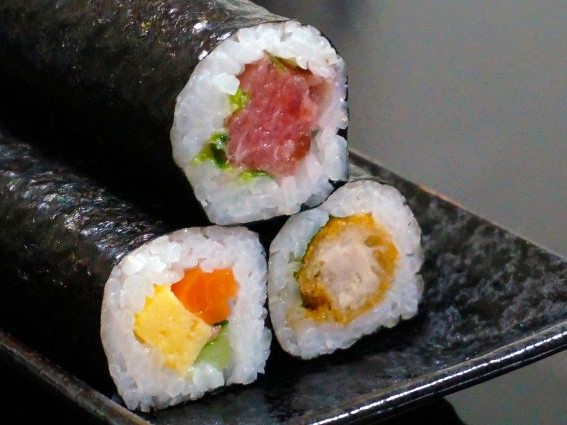
The appearance of Chu-maki
For Chumaki, cut the zenkei nori into two-thirds size, and roll it around 150-200g of vinegared rice and ingredients. Usually, 2-3 different ingredients are used for Chu-maki. Alternatively, you can use more of one type of ingredient than Hoso-maki.
2-4 Saikumaki (decorative rolls)
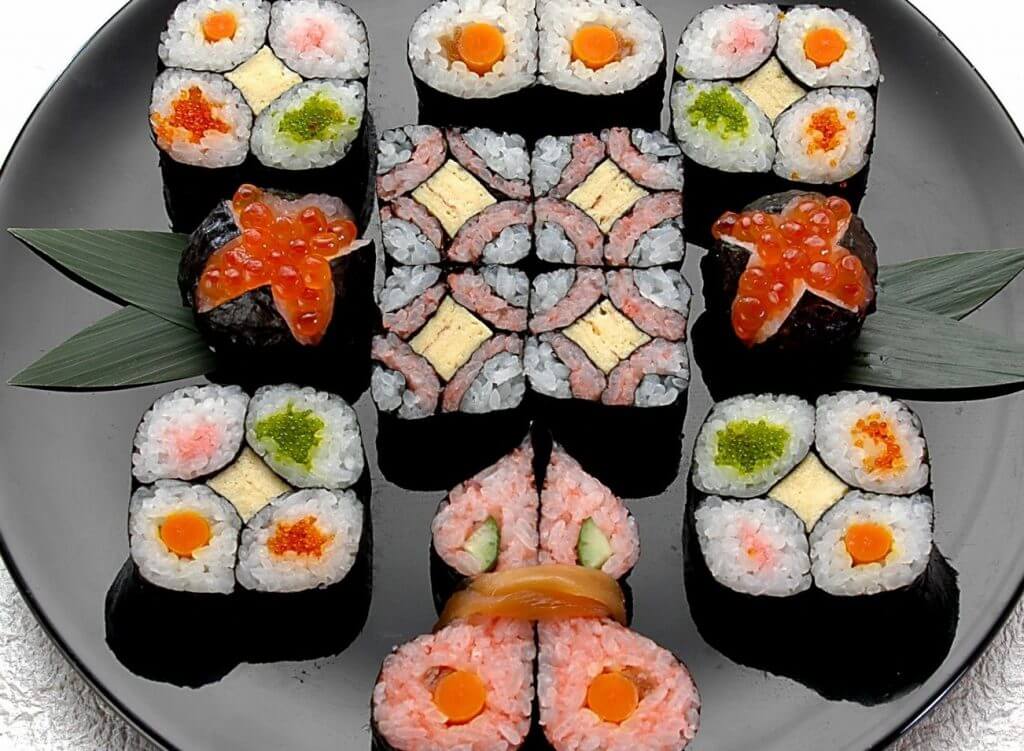
The cross-section of the cut pieces is made to look like flowers, designs, or family crests. Priority is given to the visual aspects more than the taste.
2-5 Temaki (Hand rolls)
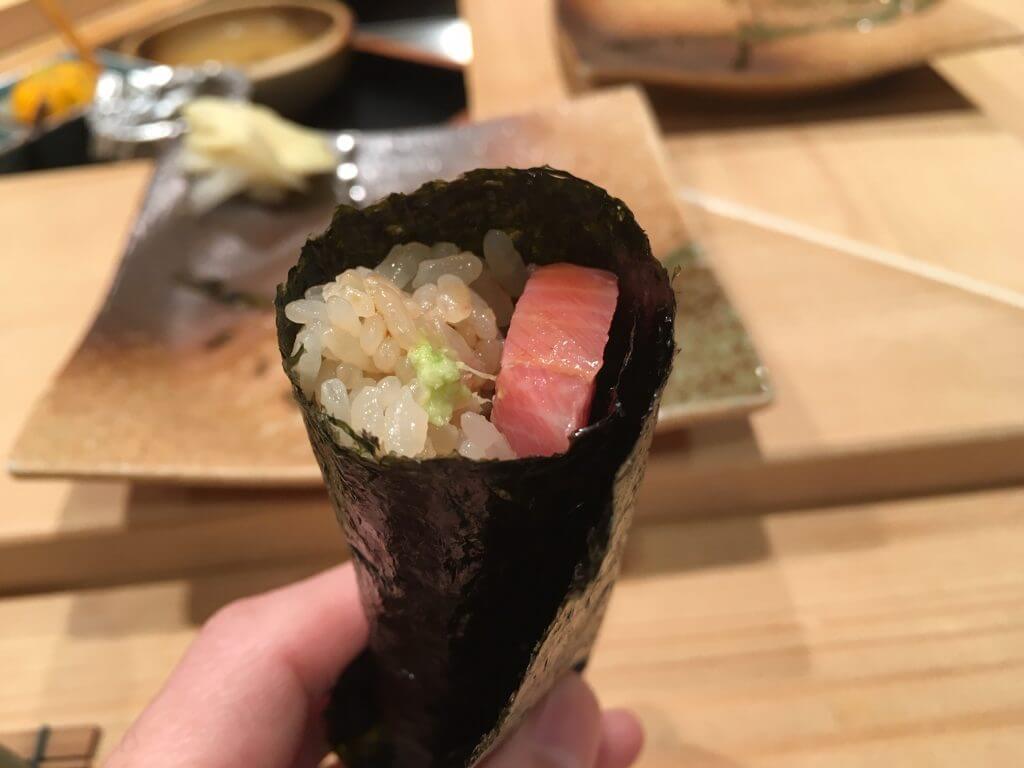
This is a new, fun way to eat sushi, and it’s certainly the easiest way. One way is to roll it very thin, like Hoso-maki, and another is to roll it wider (flower bouquet temaki). Any toppings used for Hoso-maki or gunkanmaki (battleship rolls) can be used. A sushi roll made without using a Makisu (Rolling mat) is called Temaki (Hand roll).
*In battleship rolls and skinny rolls, the seaweed absorbs the moisture of the rice as time passes. Soft seaweed that has absorbed moisture doesn’t allow you to enjoy the essential flavor of the seaweed, so the rolls should be eaten as soon as they are made.
3. Sushi Rolls
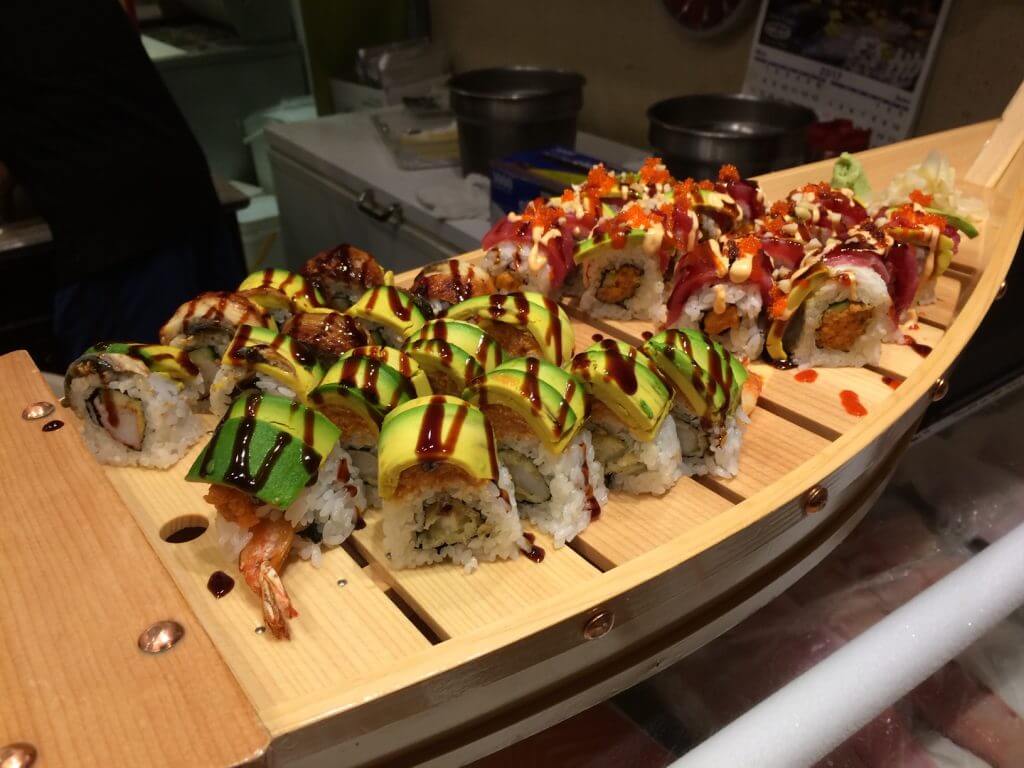
The first sushi restaurant in the US was a full-fledged counter in a corner of Kawafuku, the first Japanese restaurant in LA’s Little Tokyo, which opened during the 1960s. The sushi boom came sometime after that and ever since sushi has been loved by the American people even more than by the Japanese and it has gradually become a part of everyday life in the US.
The first thing Japanese people think of when they think of sushi is Nigiri sushi, but most sushi eaten outside of Japan is sushi rolls. Considering that seaweed and directly seeing raw fish may be off-putting outside of Japan (resulting in removing seaweed before eating), sushi rolls and those rolled with rice on the outside, are popular. Calfornia rolls set off this trend, which blew up all throughout the US. Incidentally, Calfornia rolls were first invented at the sushi restaurant in the Tokyo Kaikan in Los Angeles Lil’ Tokyo in 1965, although there is another theory that they originated in Vancouver.
You can also find Spider rolls, Philadelphia rolls, Alaska rolls, Rainbow rolls and Mango rolls, each characteristic of where they originated. T-Mobile Park in Seattle even has an “Ichi-roll” named after the famous ballplayer Ichiro Suzuki. These unique sushi dishes are made with ingredients that are easy for the chefs to procure. Sushi has also evolved from the traditional form, with toppings like arugula, beef, carrots, chicken, chili peppers and even chocolate. Although sushi was originally enjoyed as a “health food”, but the fact is that nowadays those made with fried ingredients such as Dynamite rolls, are a far cry from health food.
Then, in the 1980s California rolls were reverse imported to Japan. It even appears as a staple on the conveyor belt sushi restaurant menus in Japan. Original sushi rolls have now been developed on every continent in the world with no end in sight.
Let’s take a look at some typical sushi rolls.
3-1 Philadelphia roll – Made of smoked salmon, avocado, asparagus and cream cheese.
3-2 Spider roll – A fried soft shell crab and cucumber roll flavored with spicy mayonnaise.
3-3 Spicy tuna roll – Tuna wrapped with spicy Sriracha sauce, etc.
3-4 California roll – Made from avocado, cucumber, kanikama (imitation crab meat), Tobiko (flying fish roe), white sesame, etc.
3-5 Alaska roll – Raw salmon, kanikama, avocado and cucumber in a roll with rice on the outside, wrapped in smoked salmon.
3-6 Rainbow roll – A roll with avocado, salmon, tuna, young yellowtail, etc., lined up to look like a colorful rainbow.
3-7 Dynamite roll – A hamachi (young yellowtail) and shrimp tempura roll with carrot, avocado and cucumber, flavored with spicy mayo.
3-8 Mango roll – Avocado, kanikama and shrimp tempura roll wrapped in sliced mango instead of seaweed. It is flavored with a creamy mango sauce.
3-9 Boston roll – Similar to California rolls, but instead of kanikama, boiled shrimp is used. There are also sushi rolls made with rice on the outside, wrapped around avocado, cucumber, etc. on the inside and sprinkled with toppings like tobiko.
3-10 Miss Pink – A pink sushi made by wrapping strawberries and sushi rice in a crepe.
3-11 Sushirrito – A restaurant named Sushirrito invented a combination of Mexican burritos. The ingredients are not limited to sushi toppings and a large amount of meat, vegetables, fried foods, salad, etc., wrapped like a burrito so it can be held in your hand to eat.
3-12 B.C. roll – B.C. stands for British Columbia, the westernmost province of Canada, where Vancouver is located. It is usually wrapped with grilled salmon, crispy salmon skin, cucumber, and lettuce, and covered with a sweet and spicy sauce. This Canadian delicacy was invented in Vancouver in 1974 by a Japanese chef named Hidekazu Tojo.
3-13 Yam roll – Yam roll is filled with sushi rice, Tempura Yam or boiled and crushed, rolled in a nori seaweed wrap and drizzled with a creamy spicy Sriracha mayo dressing. Tempura Yam is used, or boiled and crushed.
3-14 Sockeye salmon roll – It is made with a core of wild sockeye salmon (red salmon), rolled with vinegared rice and nori seaweed.
3-15 Crab stick sushi roll – It is made with succulent crab meat that has been gently cooked and seasoned to perfection, then wrapped in fluffy, sticky rice and seaweed. At conveyor belt sushi restaurants, it is sometimes made with crab sticks and cucumber as the core, wrapped in nori seaweed.
3-16 New York roll – The ingredients used in the New York roll include plump prawns, crisp cucumber, and creamy avocado. Then, that trio of humble ingredients is wrapped in a layer of sushi rice and nori seaweed. Some people like the addition of sesame seeds.
Sushi rolls also might be the best option for those who prefer to avoid raw fish. California Sushi Rolls, New York Sushi Rolls, Florida Sushi Rolls, Heaven Roll Sushi, Spicy Chicken Sushi Rolls, etc. are good examples of sushi that do not use raw fish at all. They are also perfect as an introduction to sushi for beginners.
3-17 Teriyaki chicken roll – Teriyaki chicken roll features tender chicken drizzled in a sweet, spicy teriyaki sauce, cucumber, and exquisitely seasoned sushi rice.
3-18 Green chile roll – Green chile roll (referred to as a New Mexico roll outside of New Mexico) is a fusion of New Mexican cuisine and Japanese cuisine. sushi roll contains tempura-fried New Mexico green chile and vegetables (usually cucumber and either avocado or calabacitas), teriyaki sauce, wrapped in vinegared rice and seaweed. While it is usually a vegetarian roll, it can sometimes have fish or shrimp.
3-19 Alaskan roll – While the names of sushi tend to vary from place to place, the “Alaska roll” or “Alaskan roll” usually refers to a California roll topped with salmon.
3-20 Dragon roll – It is a delicious uramaki sushi roll, featuring a combination of shrimp tempura, unagi (eel), and avocado. Designed to resemble a dragon, this inside-out roll is traditionally filled with eel and cucumber, with thin slices of avocado layered on top to mimic dragon scales. It may also be garnished with flying fish roe, sesame seeds, and eel sauce. Unagi rolls are a staple in many North American sushi restaurants.
3-21 Caterpillar roll – It is a type of uramaki roll made with unagi, cucumber, nori, and sushi rice. The top of the roll is decorated with sliced avocado. This creates a striped pattern on top that resembles a caterpillar, which is where the roll gets its name. A caterpillar roll looks very similar to a dragon roll in that it’s draped with avocado slices. However, while the dragon roll contains shrimp tempura, the caterpillar roll contains unagi (eel).
3-22 Seattle roll – It is a makizushi roll named for Seattle, which contains raw Pacific salmon, cream cheese, nori seaweed, and either cucumber or avocado. Variations include ingredients such as smoked or seared salmon, and almost always cream cheese. Masago and tobiko can be added to this sushi roll.
3-23 Godzilla roll – It is a sushi roll with shrimp and green onion tempura, topped with tuna with avocado and volcano sauce, and drizzled with teriyaki sauce and bonito flakes.
3-24 Las Vegas roll – It is made by rolling shrimp tempura, tuna, and crab sticks together, coating them with tempura batter, and then deep-frying them. It is topped with eel sauce and spicy mayo.
3-25 Spicy scallop roll – Scallop and spicy masago mayo rolled inside out. It has the soft texture of the scallops and the spicy seasoning.
3-26 Sushi Sandwich (Onigirazu or Square Sushi) – It is a modern, convenient twist on traditional sushi rolls. Instead of being rolled into a cylinder, sushi ingredients are layered between two compact layers of rice and then wrapped in a square or rectangular shape using a sheet of nori seaweed. The result resembles a sandwich—easy to pack, hold, and eat.
Its origin is often associated with Western sushi trends (especially in Australia), but the concept was inspired by the Japanese dish “onigirizu,” which combines the ideas of onigiri and sushi.
The main ingredients are vinegared rice, tuna mayo, grilled salmon, teriyaki chicken, avocado and cucumber, pickles, fried shrimp or tofu, etc.
It usually contains crab salad, which is made with mayo and/or cream cheese and can be high in calories. To make this roll healthier, use unseasoned crab stick instead of crab salad.
THE PERPETUAL EVOLUTION OF SUSHI ROLLS THROUGHOUT THE WORLD
4. Musubi sushi
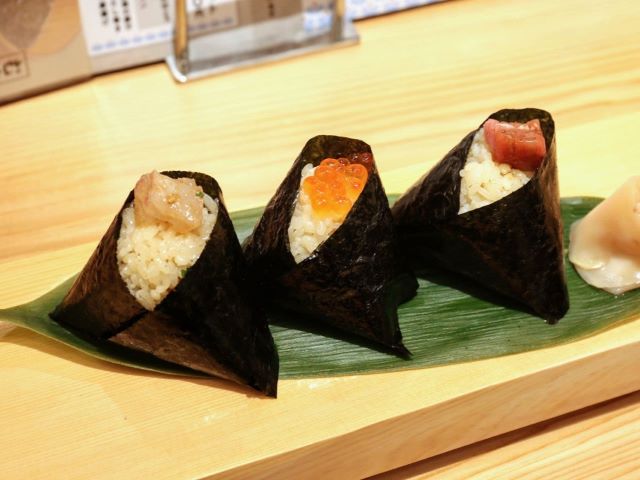
A wide variety of sushi items are available.
This sushi is an evolved version of onigiri. It is portable and can be eaten quickly with one hand. We think it is a type of sushi because it properly uses vinegared rice and sushi toppings. It was introduced to the market in 2024.
The most popular feature is the vinegared rice, which is made with “red rice (aka shari)” using red vinegar, often served at high-end sushi restaurants, and is combined with nori, a type of seaweed that is known for its crispiness.
Nigiri vs Sashimi: What’s the Difference?
There are still many people in the world who mistakenly believe that sashimi is a type of sushi, a result of misinformation. This is deplorable. The following is a correct explanation, so please read it and focus on the sushi rice.
Nigiri sushi is a cuisine in which raw seafood or fermented fish is placed on top of sushi rice. The raw fish used in Nigiri sushi known as Edomae sushi is also used in Chirashizushi, Oshizushi and Kakinohazushi. There is even sushi that doesn’t use fish, like Inarizushi and beef Nigiri sushi. The one commonality is that sushi rice is always present.
On the other hand, sashimi is a Japanese cuisine in which fresh, raw seafood eaten alone with seasonings such as soy sauce, vinegar miso, wasabi, or ginger. There is also chicken, beef and horse sashimi. Types of sashimi include “Sugata-zukuri” and “Ike-zukuri”, which are arranged in the original shape of the fish, and “Arai” which is chilled in icy water. Tataki, made of minced meat, is also a type of sashimi. Sashimi is served in a variety of restaurants including sushi restaurants, izakaya, set meal restaurants, restaurants serving Japanese cuisine, hot spring inns, etc., and is not exclusive to sushi restaurants. Sashimi is one of the national foods of Japan that you can even find in the supermarket.
As an aside, raw fish could possibly contain bacteria and parasites (Anisakis) that can cause food poisoning in humans. Therefore, according to guidelines of the Food and Drug Administration, germs are prevented from breeding through refrigeration and parasites are killed through freezing. Fish like raw tuna, which rarely contains parasites, and farmed salmon, are called things like “sushi-grade fish” or “sashimi grade” fish. However, these words are just terms used for marketing. The reason by analogy is that sushi-grade fish and sashimi-grade fish are not common in Japan.
Differences between sushi rolls and hand roll sushi
A hand roll is a type of sushi which is called “temaki sushi” in Japan. Hand roll sushi, which can be made at home, is made like crepes. Each person wraps their own ingredients in a piece of seaweed with vinegar rice and eats with their hands. The finished piece is shaped like a cone. Since it is wrapped by hand, no skill in using a makisu (bamboo mat for making sushi rolls) is required and even children can make their own. Things like soy sauce are used for seasoning. In Japan, people don’t eat while they walk, but it’s sometimes compared to hot dogs outside of Japan.
On the other hand, a sushi roll is a type of sushi that is also called “maki sushi” or “seaweed rolls” in Japan. Sushi rolls can also be made with your own preferred toppings and are wrapped with vinegar rice, but generally, a bamboo mat is used to roll into a round tube shape. The tube is cut into four to six bite-sized pieces then eaten with chopsticks or by hand. In Japan, sushi rolls are categorized into futomaki (thick rolls) and hosomaki (thin rolls), and of course the rolls with rice on the outside, popular overseas. Seasonings like soy sauce are used as necessary.
4. Chirashi-zushi (Chirashi-sushi)
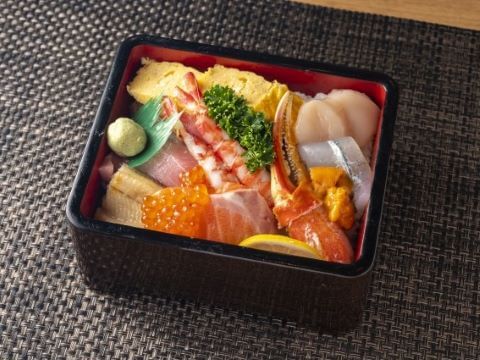
Chirashi-zushi looks the same pretty much everywhere, but the details differ a lot depending on if you’re in Kanto, Kansai, or other regions. Of course, it’s never called by the region, like “Kanto Chirashi-zushi.” Chirashi-zushi has the same name everywhere in the country.
Let’s start by explaining Chirashi-zushi and Bara-chirashi in the Kanto region.
The Chirashi-zushi you find in Kanto has a vinegared white rice base with a variety of toppings (seafood, egg omelet, dried gourd shavings, shiitake mushroom, minced fish, pickled ginger, etc.), served in a container, often a square nesting box. “Chirashi” means “scatter” in Japanese and Chirashi-zushi is called this because the ingredients are scattered over the vinegared rice. This is also called “Fukiyose (this comes from the drifting waves) chirashi” or “Nama (raw) chirashi”. Large cuts of the ingredients are often used, creating a bold dish.
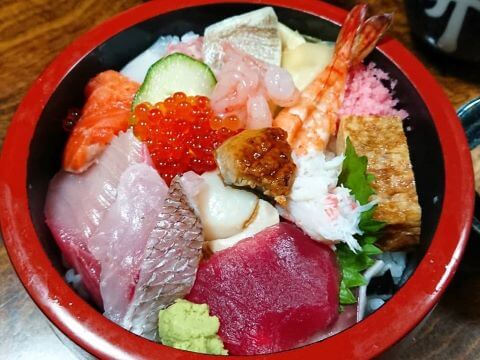
The toppings are seasoned with wasabi and shoyu. When made with regular rice instead of vinegared rice, it is called a seafood bowl. The dish it is served in can be square or round. However, a black dish is usually used to bring out the colors of the sushi. Ingredients are not layered in the container, but instead arranged three dimensionally. In rare cases, chopped Kanpyo or gari may be mixed with the vinegared rice.
It is made with raw toppings such as Maguro, Tai, Ika and Kurumaebi as well as sweet toppings such as Tamagoyakai, Kinshitamago, Shiitake mushroom, Kanpyo and Oboro. Naturally, various toppings and sushi rice are eaten together, but sometimes it is enjoyed with sake. First, enjoy raw toppings such as Maguro, Tai and Ika with sake as Tsumami. Sweet toppings are eaten with sushi rice to finish up the meal.
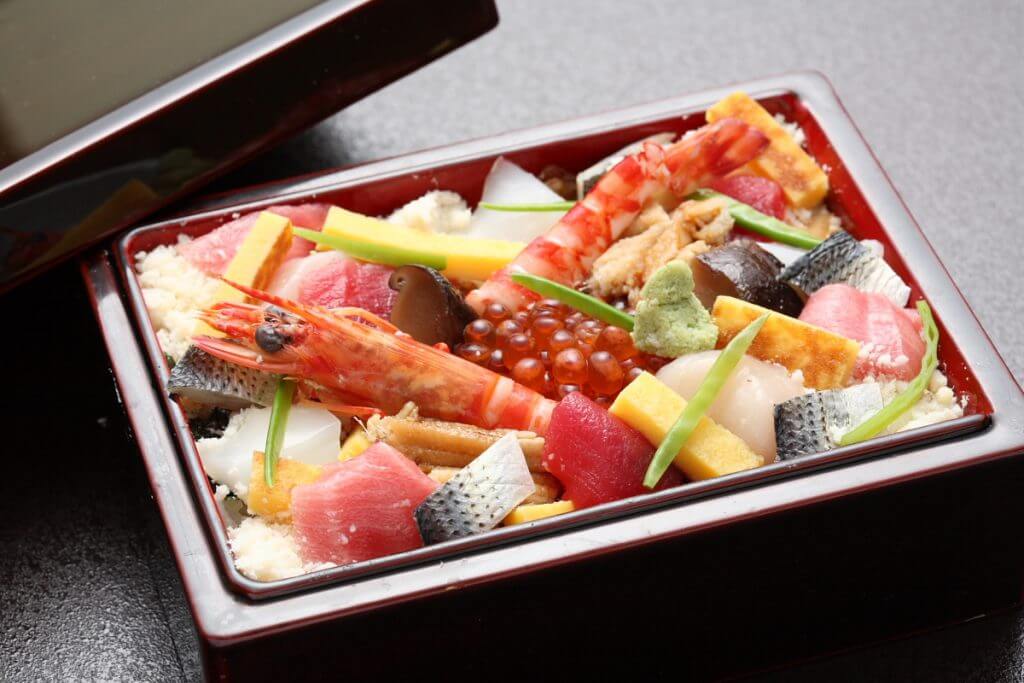
“Bara-chirashi” is white vinegar rice topped with ingredients that have prepared in the Edo-style by marinating in vinegar, boiling, or marinating in soy sauce, egg omelet, sweet and salty boiled shiitake mushrooms, dried gourd shavings, and minced fish, sliced up thinly. The ingredients are already seasoned and eaten as they are.
Also, at sushi restaurants, Nigiri sushi made from raw fish cannot be taken home due to the risk of food poisoning. Therefore, Bara-chirashi, which uses cooked and vinegar-marinated toppings, is used for takeout instead.
Kanto Chirashi-zushi (fukiyose-chirashi or bara-chirashi) was made from converting Nigiri sushi, so the vinegared rice is made in the same way, with just a little bit of sugar and eaten warm. If you wait too long, it gets cold and hardens. One of the charms of this dish is using the same vinegared rice as the sushi, for a refreshing flavor.
On the other hand, the Chirashi-zushi in Kansai is called “Bara-zushi” or “Gomoku-zushi.”
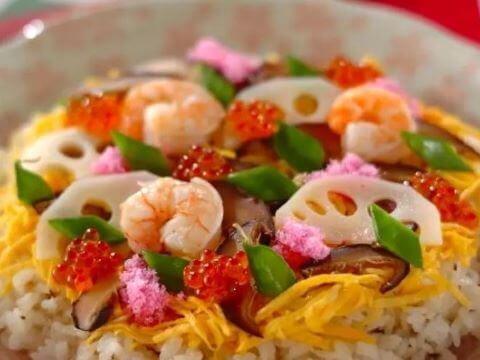
The main ingredients are vegetables, mixed in with the vinegar rice, then topped with boiled octopus and shrimp, and grilled conger eel, boiled and chopped green beans, omelet cut into thin strips, chopped seaweed, gari (ginger), or red pickled ginger. Gomoku-zushi is a Japanese dish made at home that can be eaten at Hinamatsuri and other festive events. Since the vinegared rice cools down slowly, the rice absorbs enough vinegar so that the taste does not change even as time passes. However, the characteristics differ depending on the region, as do the ingredients used and the appearance.
The most famous is Bara-zushi in Okayama. Because of the use of abundant ingredients, it was said to cost “One ryo of gold per box,” (one ryo is equivalent to about US $3500 in 2022 and one box had a capacity of about 1800 cc), and it is a traditional sushi that always appears at celebrations such as festivals, housewarming gifts, and for the hospitality of important guests. It is characterized by using plenty of fish and shellfish and vegetables caught and harvested during that season. Moreover, it is a luxurious dish that takes a lot of time and money because each individual ingredient requires preparations in advance.
It seems that most regional variations of chirashi-zushi have their roots in “bara-zushi.” Historically, bara-zushi is much older, and the Kanto version of chirashizushi is a rather new way of eating the dish. The raw toppings are also a post-war addition.
5. Inarizushi (Inari sushi)
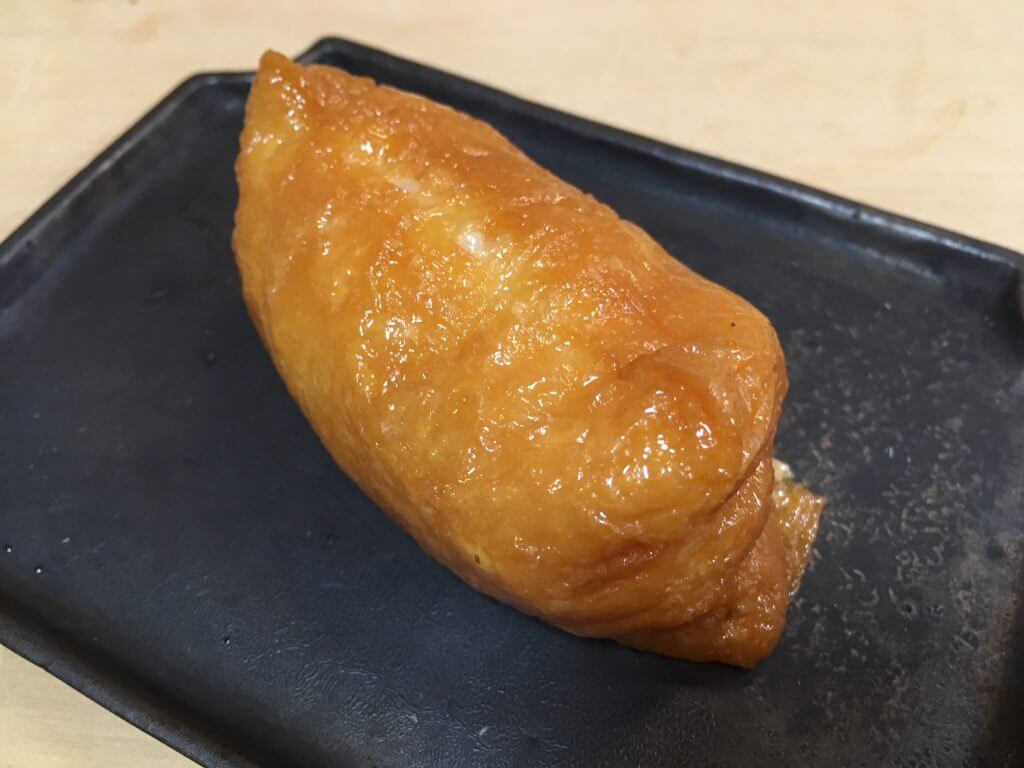
Fried bean curd and vinegar rice (or vinegar rice mixed with boiled down carrots, shiitake, or similar ingredients). Inarizushi is made with only two ingredients, and it is that simplicity that allows the chef to devote their ingenuity to the dish, creating a unique flavor. It is said to have first appeared at the end of the Edo period, but the origin is uncertain.
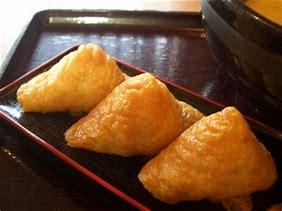
The shape of Inarizushi differs from that resembling a straw bag in the Kanto and Eastern Japan, where rich sweet and salty flavoring is used, and the triangular shape of Western Japan.
Tips for making great Inarizushi from a sushi chef
What is Inarizushi (Inari sushi)?
6. Others
6-1 Temarizushi
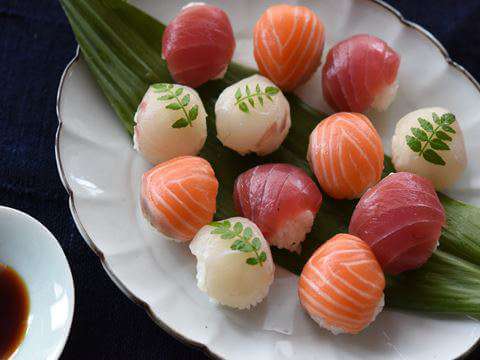
Like its namesake, Temarizushi is small and shaped like traditional Japanese toy balls. It is a type of Sosakuzushi (sushi not restricted by Edo-style rules, allowing for creativity). Some say this type of sushi originated in Tokyo.
6-2 Masuzushi (Trout sushi)
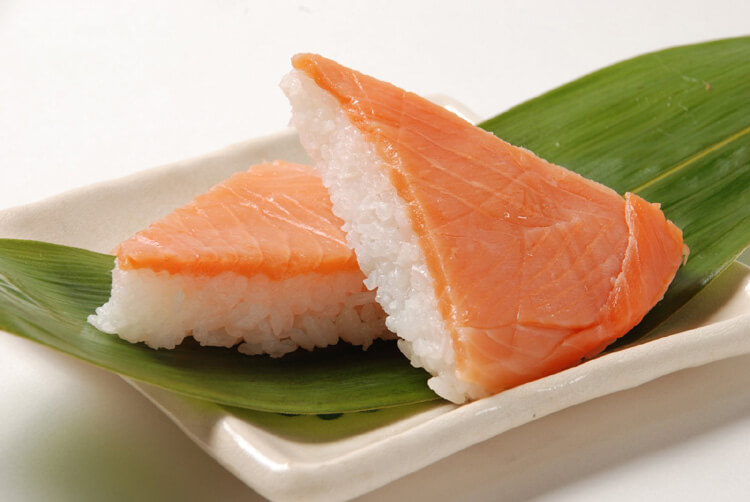
Masu-zushi is from Toyama. Vinegar rice is spread on a bamboo leave and vinegared masu salmon (Sakuramasu) is put on top.
6-3 Pacific Saury Bozushi
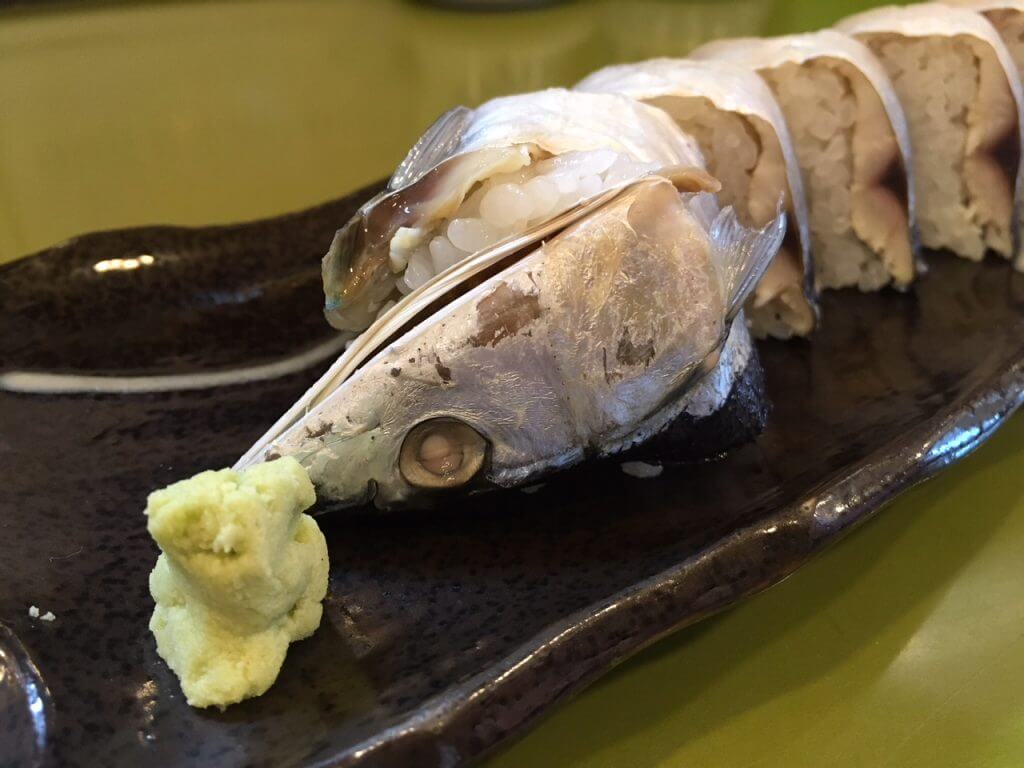
Whole saury is sliced down the back, then spread over vinegar rice, then pressed a bit to create a shape. The “Pacific Saury Sugata-zushi” is representative of the Kumano region.
6-4 Funazushi (Crucian carp sushi)
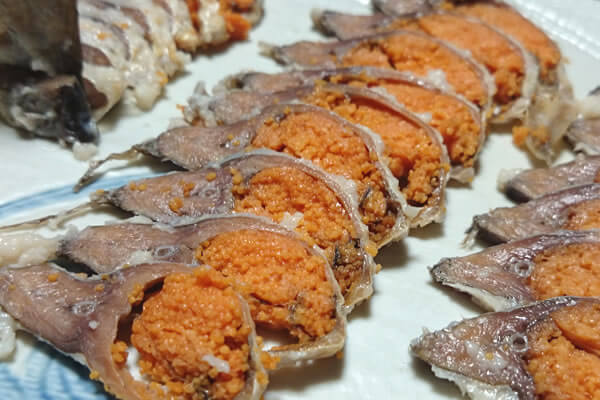
Shiga is known for its delicious Funa-zushi, made from the crucian carp of Lake Biwa. This is one type of Nare-zushi (fermented sushi) that retains the original sushi form.
As you can see, there are various types of sushi throughout Japan, and some are not well-known outside of certain regions. If you have the opportunity to visit any of these regions, be sure to have a taste.
6-5 Sasamaki sushi (Bamboo leave sushi)
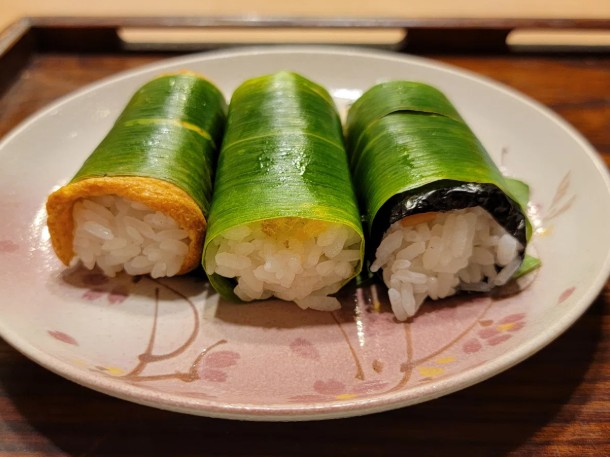
The appearance of Sasamaki sushi
Sasamaki sushi, as the name suggests, is sushi wrapped in bamboo leaves. In the past, without refrigeration, the key was to preserve the sushi, so it was made with a generous amount of salt and vinegar. Sasamaki sushi is also known as “kenuki zushi,” and there are still shops that have been making it since the Edo period.
The seven-colored toppings include tuna, oboro, omulet, nori seaweed, Hikarimono, and Shiromi, with the Hikarimono and Shiromi varying by season.
Hikarimono include Spanish mackerel in spring, Japanese halfbeak and horse mackerel in summer, and kohada from autumn to winter. Shiromi includes yellowtail and Greater amberjack (Kanpachi). In the short spring season, Japanese icefish (Shirauo) is simmered in mirin, sugar, and vinegar, and abalone and scallops are also used.
The vinegar rice is made with a sticky texture to keep it fresh over time. It is best enjoyed after about three hours, when the salt and vinegar have blended with the bamboo leaf aroma, enhancing the flavor.
6-6 Kaburazushi (Kabu and buri sushi)

The appearance of Kaburazushi
Kaburazushi is a fermented food made by sandwiching salted turnips (Kabu) and salted yellowtail (Buri) between rice malt and allowing it to ferment. It is not sushi made with vinegared rice, but rather a type of narezushi (fish fermented with salt and rice). It is eaten as is, without any accompaniments, once it has matured. It is a fermented food that is a local dish of the Hokuriku region, mainly in Ishikawa and Toyama prefectures.
6-7 Chakinzushi (Sushi wrapped in thin omelette)
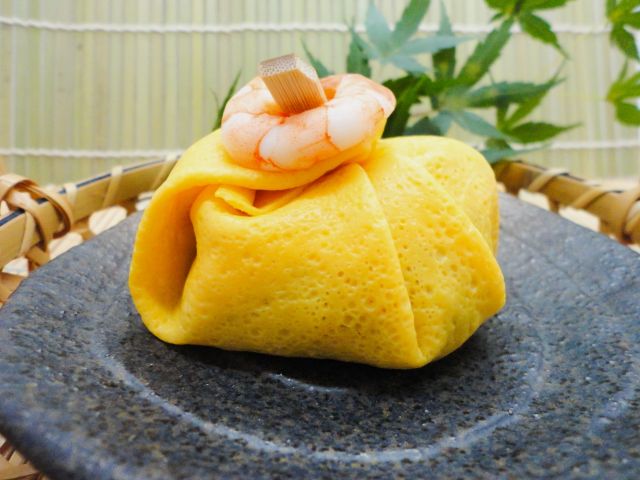
The appearance of Chakinzushi
Chakinzushi is a type of sushi made by wrapping vinegared rice in kinshi tamago (thinly sliced or shredded omelet), also known as “Kinchakuzushi” or “Fukusazushi.” It often contains Gomoku sushi, which includes seafood, shiitake mushrooms, sesame seeds, and other ingredients. By the way, the “Chakin (tea towel)” in Chakinzushi refers to the cloth used to wipe tea bowls in the tea ceremony.
6-8 Sakezushi (Kagoshima-style sake-marinated sushi)
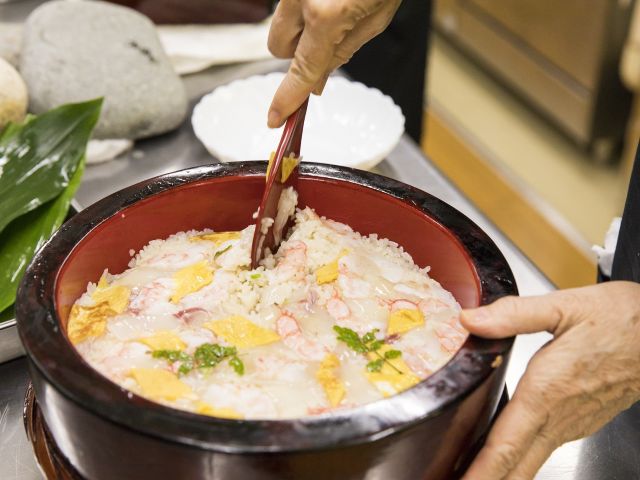
The appearance of sakezushi
It is said that the lord of the Satsuma domain, the Shimazu clan, left the leftover food and sake from a cherry blossom viewing banquet in a barrel, and the next day, it had fermented and emitted a pleasant aroma, marking the beginning of this dish. It is a dish similar to “oshi-zushi,” made by mixing sake-soaked rice with marine and mountain-based foods, seasonal ingredients, and then letting it sit for half a day before eating. Instead of vinegar, Akumochizake (sake preserved with wood ash) is used to ferment the rice, which is why it is called sushi.
6-9 Okatazushi
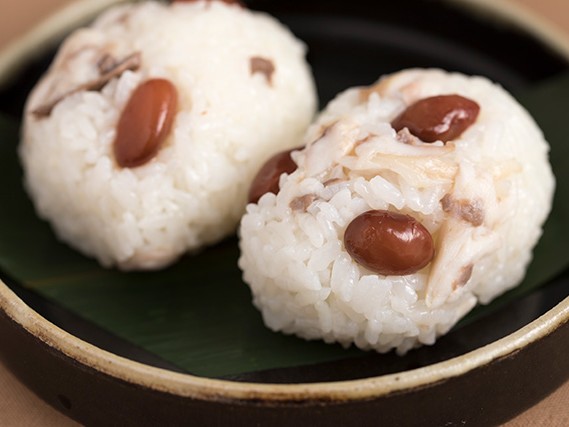
The appearance of Okatazushi
Okatazushi is made by mixing vinegar rice with grilled and flaked horse mackerel and sweetly simmered pinto beans, then shaping it into straw-shaped forms. Okata refers to a village headman. It is said to have originated when, before the busy farming season began, the village headman would serve this dish to his tenant farmers as a token of his appreciation.
6-10 Shirohatazushi (Sailfin sandfish sushi filled with tofu okara)
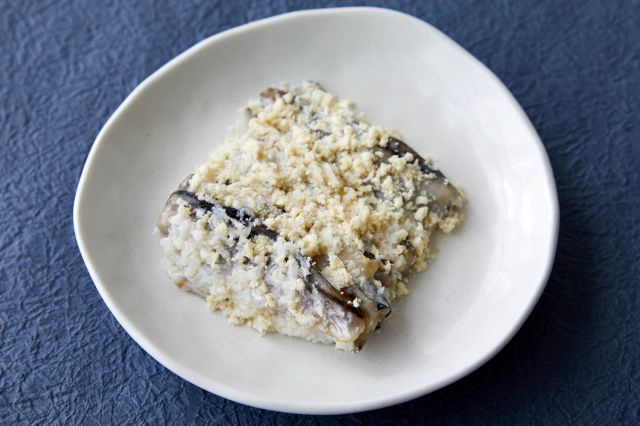
The appearance of Shiromatazushi
Shirohata is the local name for Sailfin sandfish (Hatahata) , a specialty of Akita Prefecture. Hatahata is found along the Japan Sea coast from Hokkaido to Yamaguchi Prefecture, but the Hatahata caught in Tottori Prefecture is in season in spring during the Hōenya Festival. Since they are caught while migrating off the coast of the Sanin region, they do not have eggs, but this results in a rich, melt-in-your-mouth flavor. Although it is called sushi, it is made without vinegar rice, instead filled with tofu okara. This makes it a healthy and unique dish with a distinctive texture.
6-11 Hobazushi (Japanese bigleaf magnolia sushi)
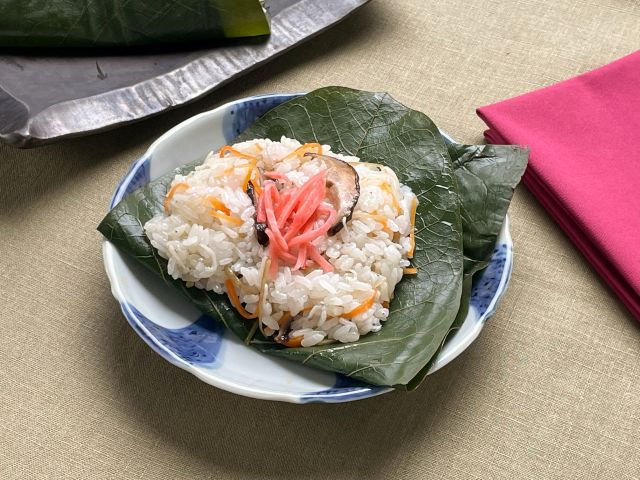
The appearance of Hobazushi
Hobazushi is made by wrapping vinegared rice, pickled salmon, and sweetly simmered mountain vegetables in Japanese cucumber tree leaves. It has been treasured as a dish served to those who helped with rice planting.
The leaves of the Japanese cucumber tree are said to have antibacterial properties as well as mold-preventing effects. In particular, the enzyme “hinokitiol” found in the leaves has high antibacterial properties and, when combined with the vinegar in the rice, was particularly useful during the rice planting season when high temperatures and humidity made food spoilage a concern.
In the Tokai region of Gifu Prefecture, many households wrap the rice in a wrapper filled with colorful ingredients such as Kanroni (simmered fish in sweetened soy sauce), vinegar-marinated mackerel, shredded omelet, and red ginger, totaling 7–8 varieties. In the Hida region, a simpler version with just vinegar rice and myoga ginger is preferred.
6-12 Yakisabazushi (Grilled mackerel sushi)
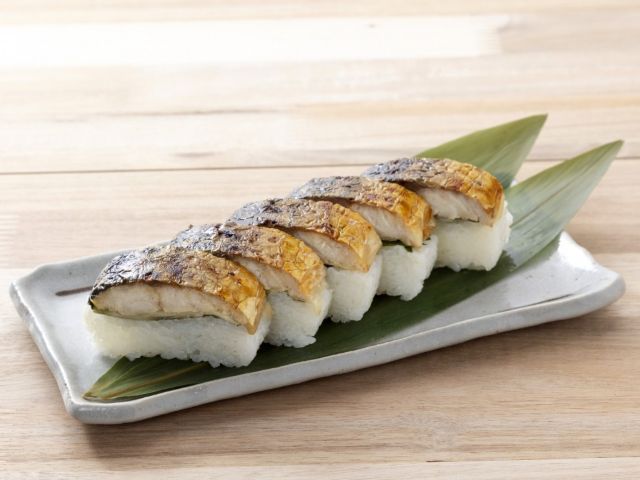
The appearance of yakisabazushi
Yakisabazushi is a type of pressed sushi that has recently become popular as a specialty of Fukui Prefecture. Unlike Kyoto’s “Sabazushi,” it is made by pressing fatty “grilled mackerel” together with vinegared rice. The aromatic flavor of the grilled mackerel harmonizes perfectly with the sweetness and acidity of the vinegared rice, creating a truly exquisite dish.
6-13 Tekonezushi
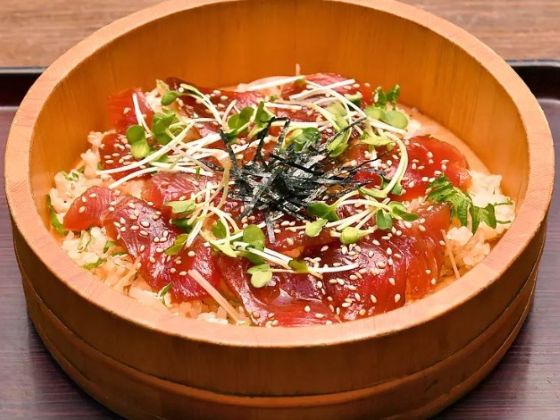
The appearance of Tekonezushi
Tekonezushi got its name because fishermen would fillet the fish they caught right on the boat and mix it by hand. Slices of red meat like bonito or tuna, prepared as sashimi, are marinated in a sauce made with soy sauce and other ingredients. These are then arranged on top of vinegared rice in a hangiri (flat-bottomed wooden tub), and garnished with toppings like shiso or nori.
Dishes you may find at sushi restaurants that are, strictly speaking, not sushi
Seafood Bowl
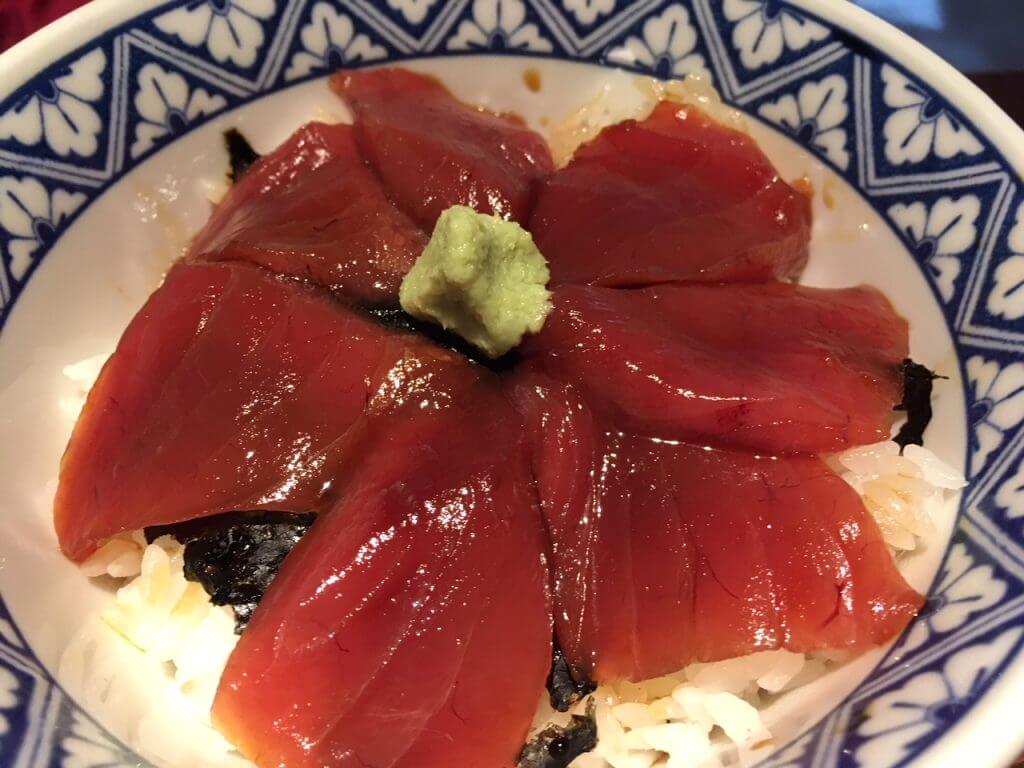
This is a rice bowl, generally served with warm rice (normal, steamed rice), with a variety of seafood sashimi on top. However, at sushi restaurants, vinegar rice is used instead of white steamed rice and it’s usually called a Seafood Bowl as well. So, it is difficult to distinguish between the two. Ingredients may include tuna, salmon roe, sea urchin, crab, squid, etc. However, toppings made in the Edo-style are not used.
Sashimi (raw fish)
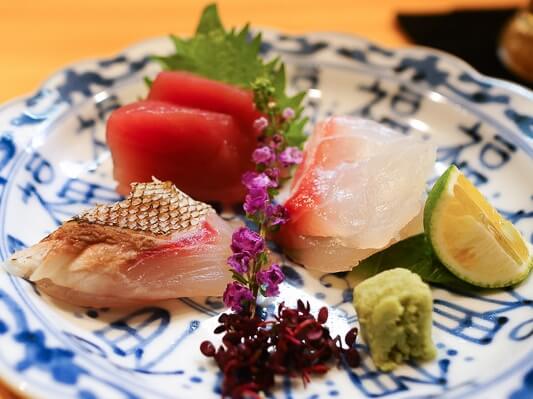
This is not categorized as sushi. Seafood is cut thinly in the raw form, then eaten with soy sauce and wasabi. It’s also called “otsukuri.”
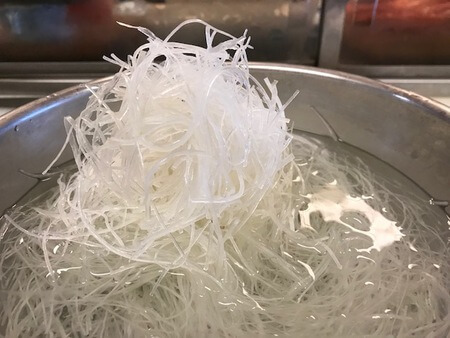 Next to the sashimi will be a garnish. The white part is daikon radish. The orange part is carrot. The green leaf is a shiso leaf. Others may include wakame seaweed, beni-tade (red polygonum), chrysanthemum, inflorescence of shiso, etc. There are various types of garnish including some that offset the odor of raw fish, some with antibacterial effects that prevent damage to the sashimi, and some types that help digestion. Garnishes that especially provide flavor are called “Yakumi.” For example, wasabi or ginger.
Next to the sashimi will be a garnish. The white part is daikon radish. The orange part is carrot. The green leaf is a shiso leaf. Others may include wakame seaweed, beni-tade (red polygonum), chrysanthemum, inflorescence of shiso, etc. There are various types of garnish including some that offset the odor of raw fish, some with antibacterial effects that prevent damage to the sashimi, and some types that help digestion. Garnishes that especially provide flavor are called “Yakumi.” For example, wasabi or ginger.
The lack of vinegar rice is not the only difference between sashimi and sushi. With sashimi, the crunchy texture is prioritized, so the fish is eaten as freshly as possible. This is completely different from Edo-style sushi, where the idea is to mature the topping and eat it when the umami element is at its peak. There is not only one kind of sushi.
Incidentally, sashimi has been eaten since long ago, but when fish is just displayed at the shop, it’s not clear what type of fish it is. So at that time, the meat was served pierce with the tail and head of the fish. That’s where the name “sashimi,” which means “pierced meat” came from.